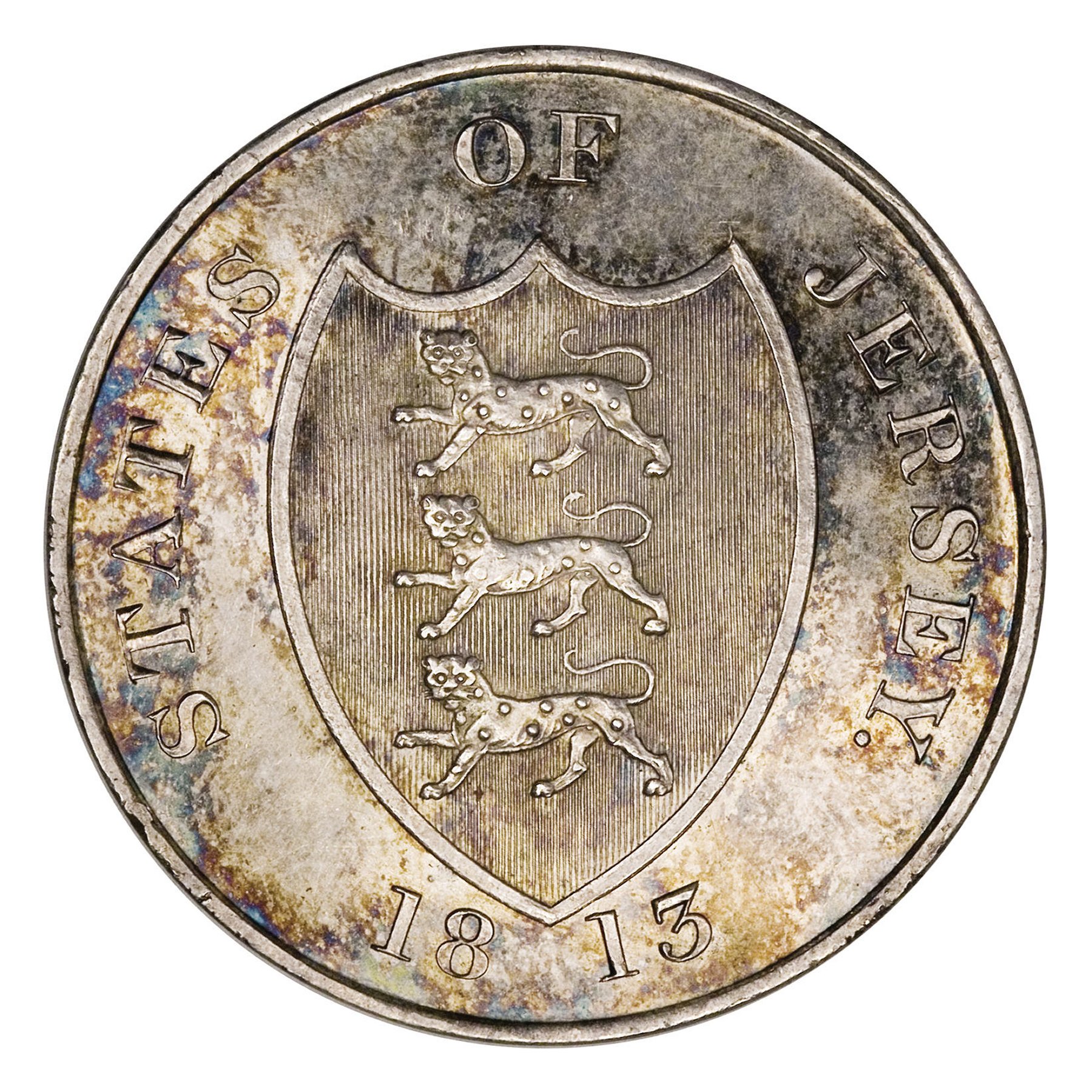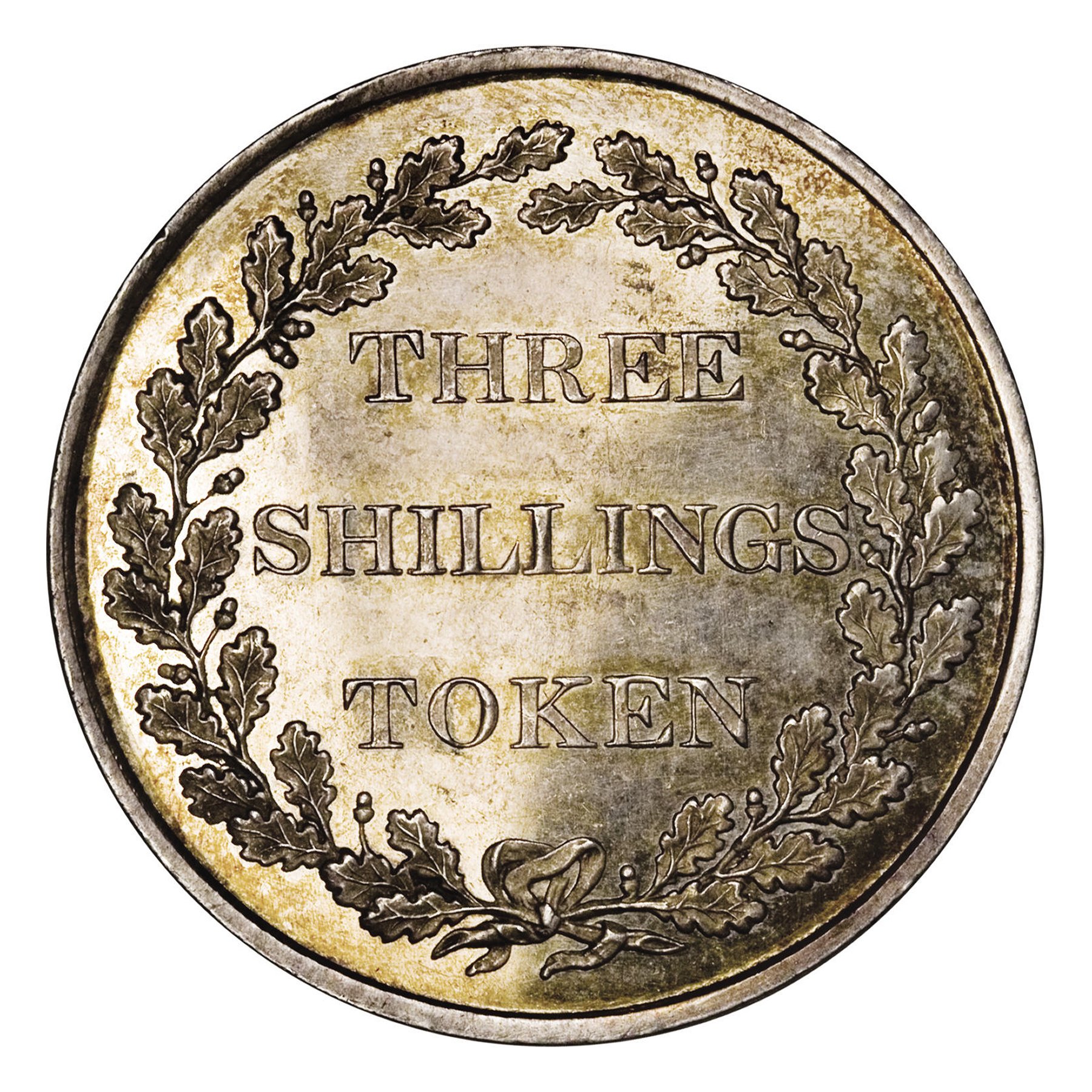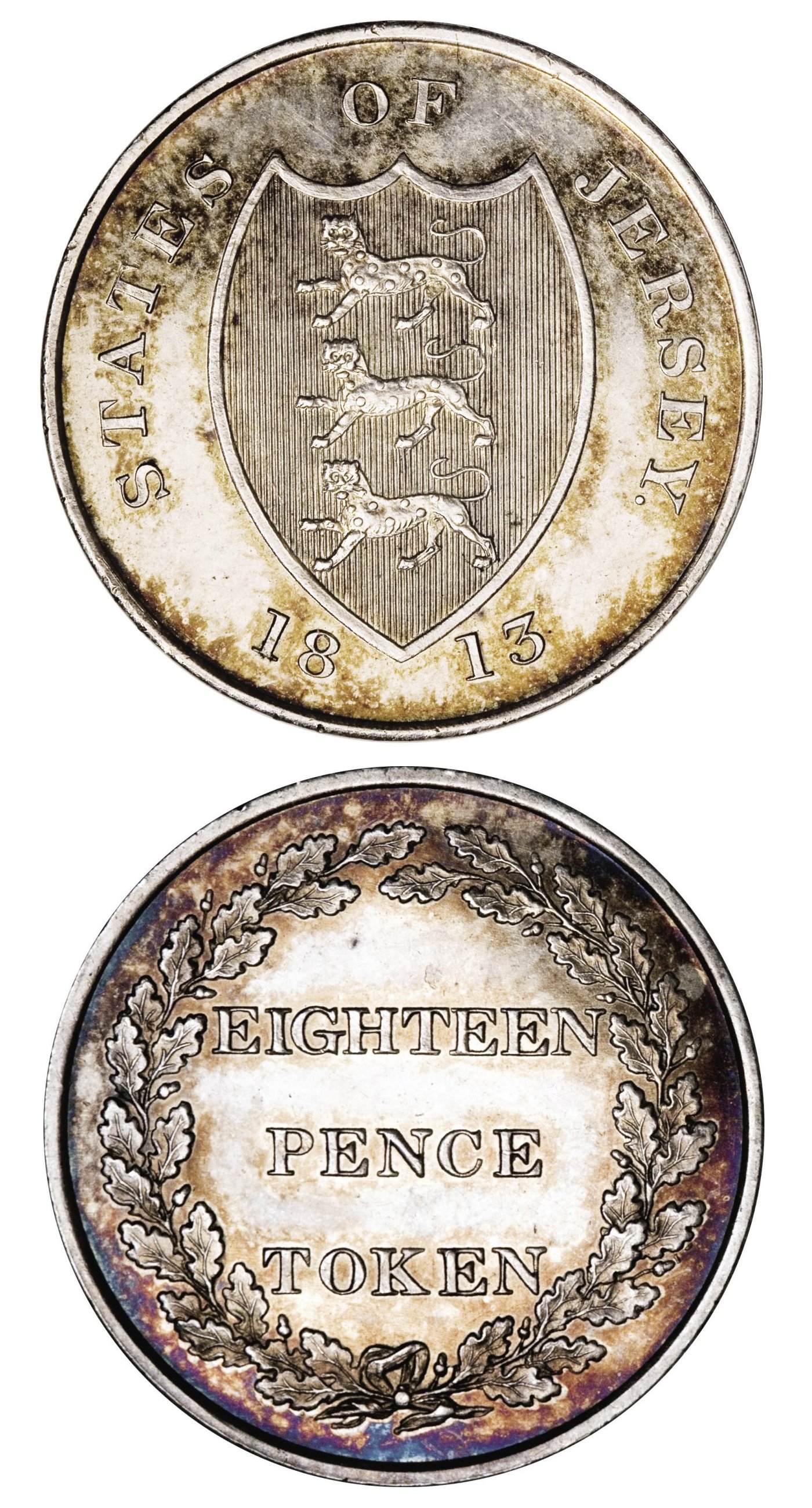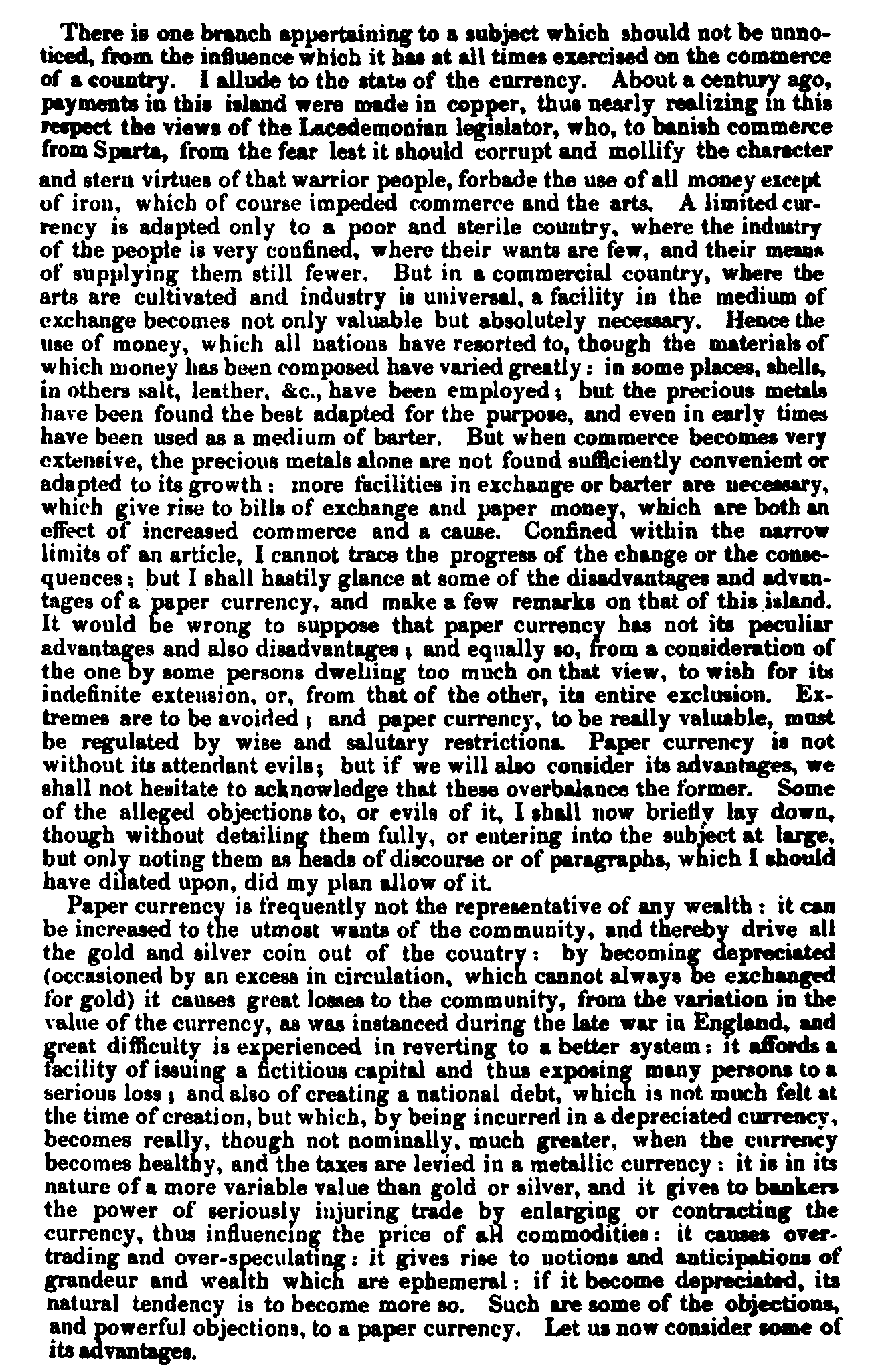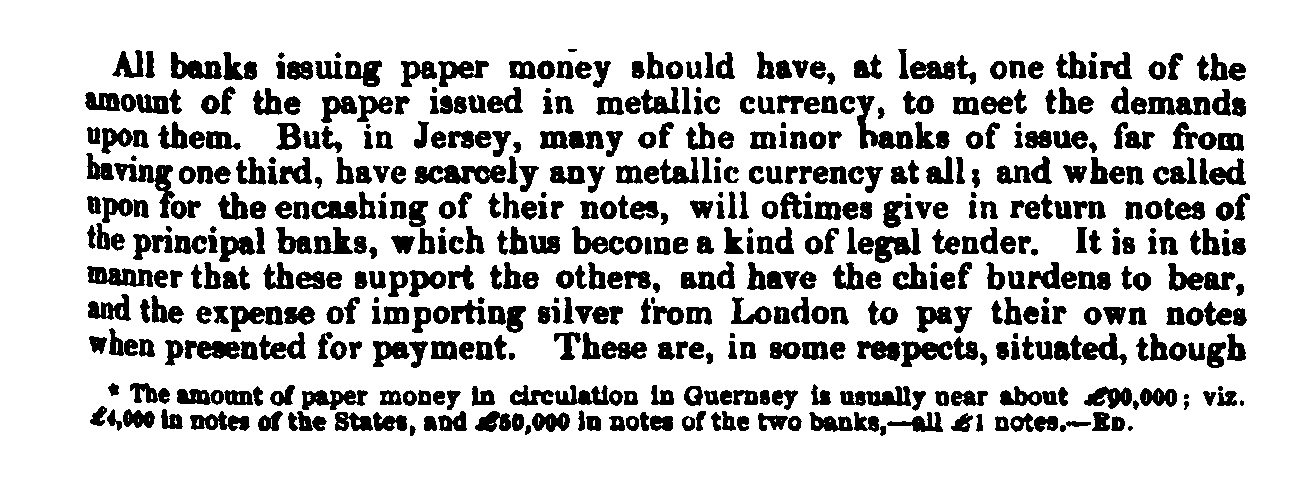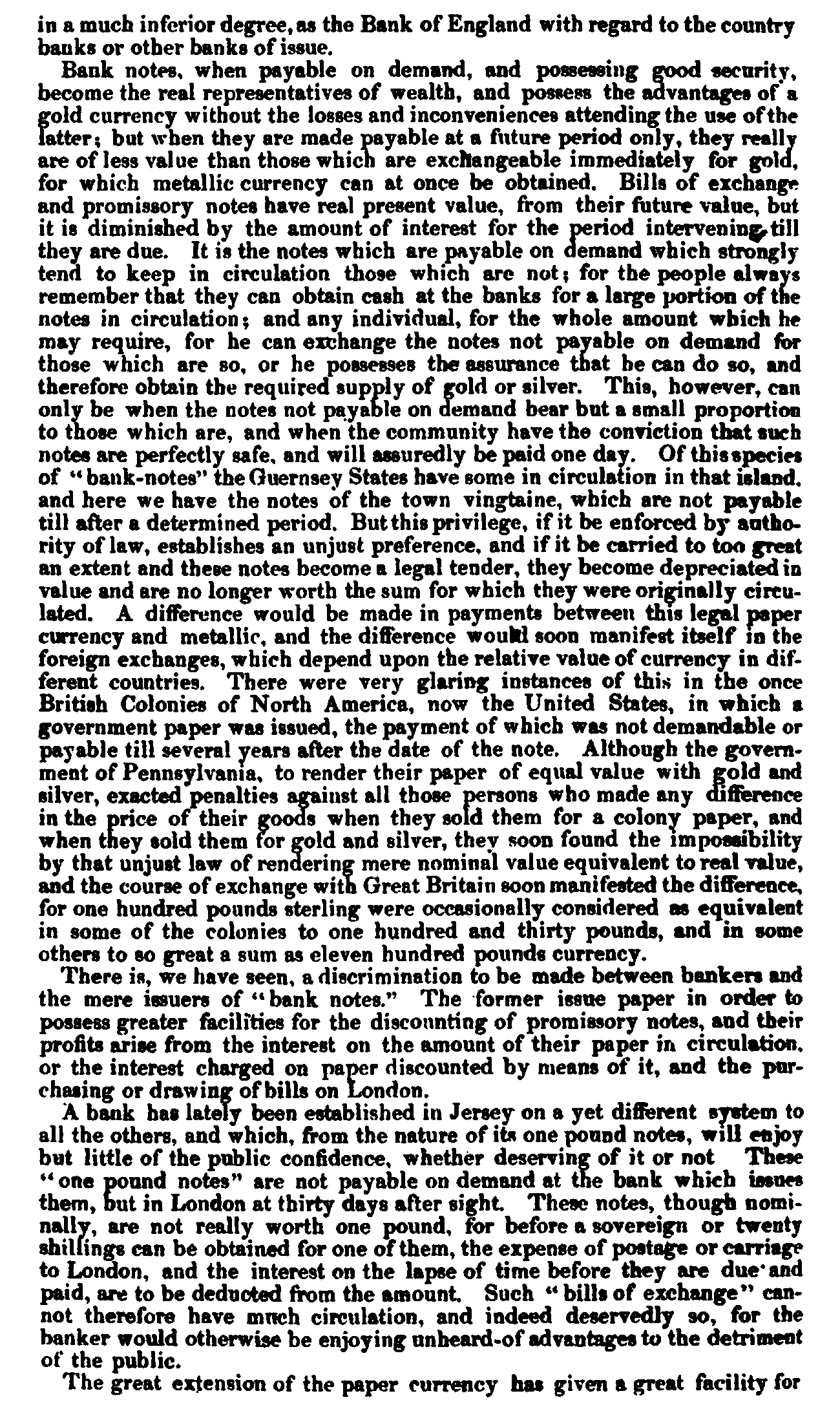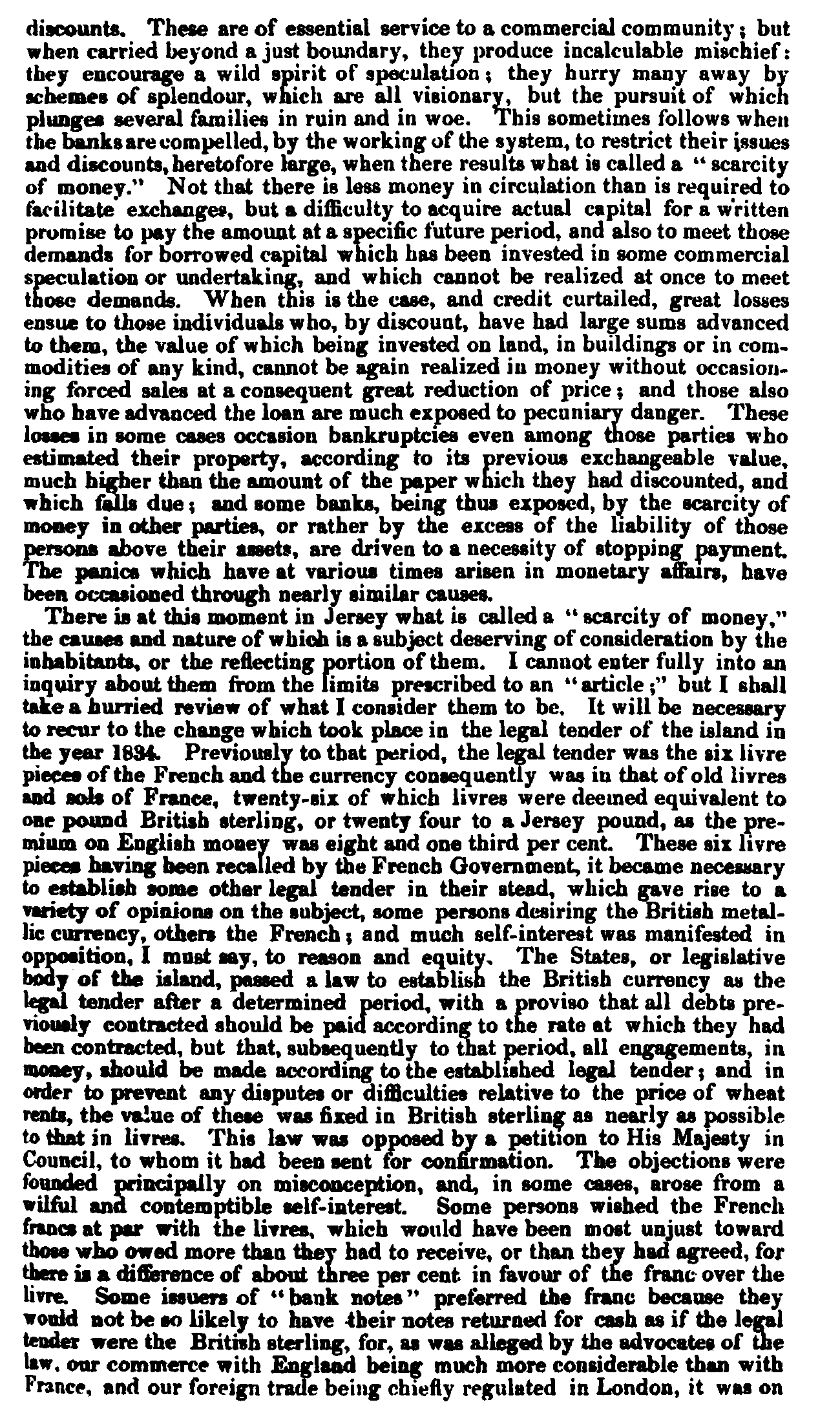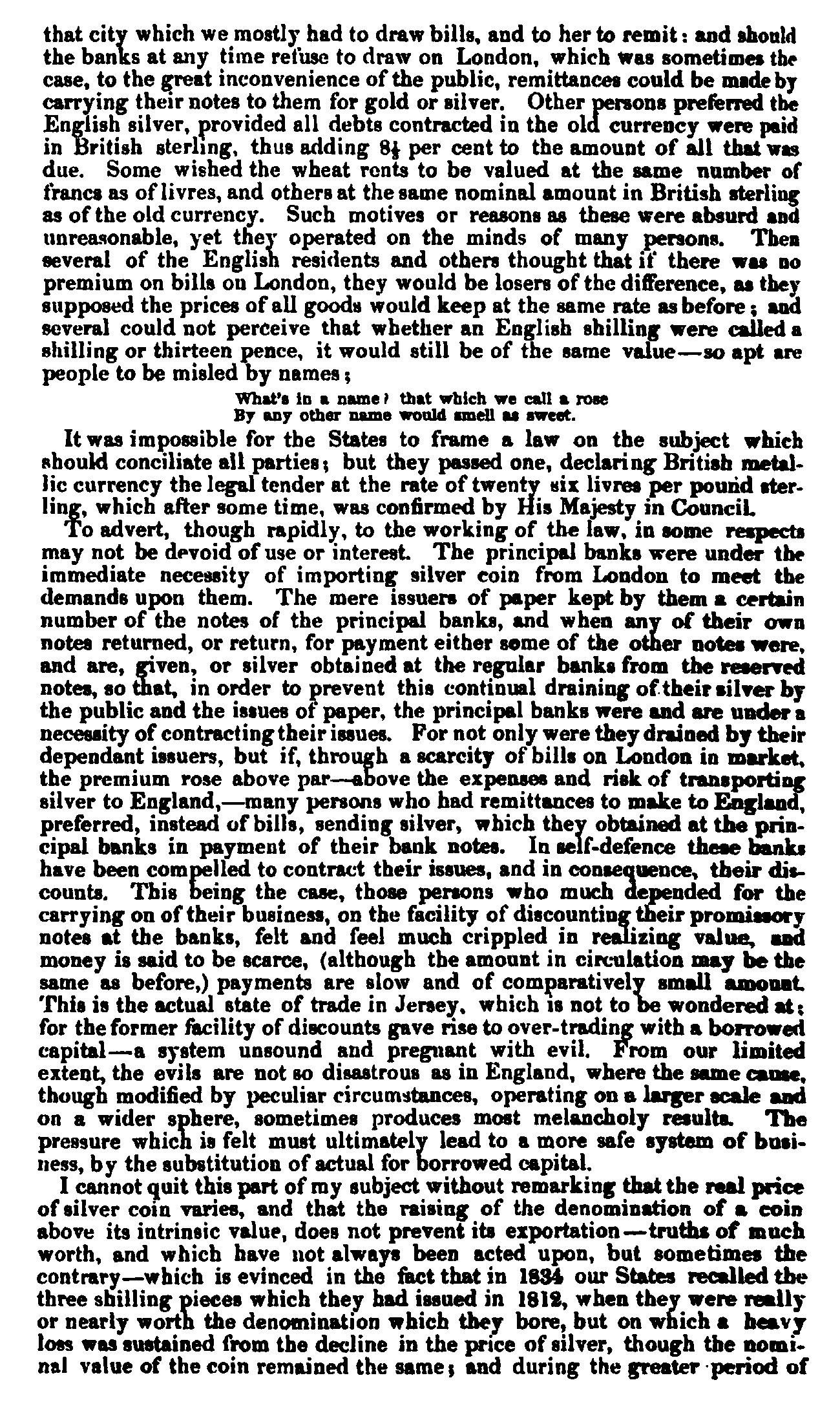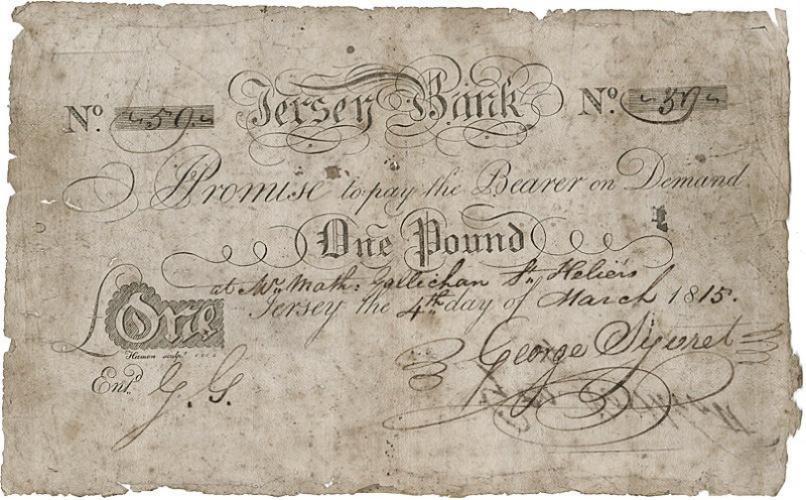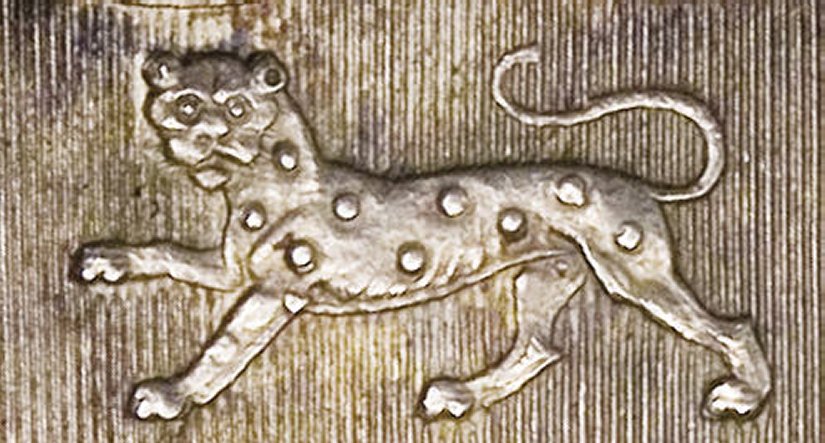
 |
| From the Shield on an 1813 Three Shillings Token |
“Much inconvenience having been felt by the Public here from the great scarcity of specie. The States met yesterday and passed the enclosed Act, by which Your Lordship will perceive that this assembly is desirous of issuing a local coin provided such a measure should meet with the approbation of His Majesty's Government.
I have to report to your Lordship that every effort to keep a sufficiency of circulating specie in this island has proved ineffectual and I therefore take the liberty of recommending that the measure now proposed may be sanctioned.
The States in the first instance intend to cause about six thousand pounds Sterling to be coined in small silver pieces and stamped with the Arms of the Island and to cover the expense of coinage, carriage, freight, and insurance. The intrinsic worth of the pieces will be a little less than the nominal value at which they will be issued.”4
“I heartily wish that you could get your States to authorize the coinage of Ten Thousand Pounds in Guernsey tokens. This with the coinage ordered by the Jersey States would set all disputes and differences respecting money matters at rest for ever.It is interesting to note that the Royal Mint was not the first place the States of Jersey requested to make these tokens. In December 1812, the States requested Matthew Boulton's Soho mint to strike these tokens.16 In addition to the Royal Mint's eventual eighteen pence and three shilling tokens, a one shilling token was also requested. The allocation was to be:
|
“The coin current in Jersey was, until lately, chiefly that of France, with a small proportion of Spanish money. The usual amount of specie, in circulation, has been estimated at nearly £80,000 sterling. After the French revolution, the coin of England became more generally into use, until the increased value of gold and silver completely drained the island of all specie but copper, and even that became scarce. There were, at this period, three regular banking houses in the town of St. Helier. These, and a few mercantile men, were accustomed to issue notes, payable to the bearer on demand, for twenty-four livres French currency. So great, however, and so increasing were the inconveniences occasioned by the almost total disappearance of silver, that those houses were obliged to issue notes of five and ten shillings: these induced individuals to do the same; all having "Jersey Bank" on their notes; until there were about eighty of these soi disant bankers. The island was soon inundated with notes, from the value of one pound down to that of one shilling; many of them issued by the lowest description of traders and publicans. Alarming as this undoubtedly was, necessity gave to these notes a general and ready circulation.
Seriously aware of the ultimate consequences, likely to result from this unrestrained emission of paper money, the States resolved to have a silver coin struck: accordingly a quantity of tokens was issued, bearing the value of three shillings, and of eighteen pence English, to the amount of £10,000 sterling.* The issuing of notes under the value of one pound sterling, was then forbidden; yet such apprehensions respecting the notes still in circulation were excited among the country inhabitants, that those who attended the market, hoarded all the coin and tokens they could procure: this was at least the reason assigned and generally believed, for the disappearance, in a few months, of nearly all the newly coined silver. The scarcity still continues, though not in the same degree.
* About the value of £2600 sterling has been added. The States have since made an act, whereby every person issuing notes payable to bearer, is to have a regular office for the payment of them in the town of St. Helier. In consequence of this regulation, many have withdrawn their notes from circulation. The rapidly increasing evil is thus checked, but the public security will probably render stricter measures necessary”.
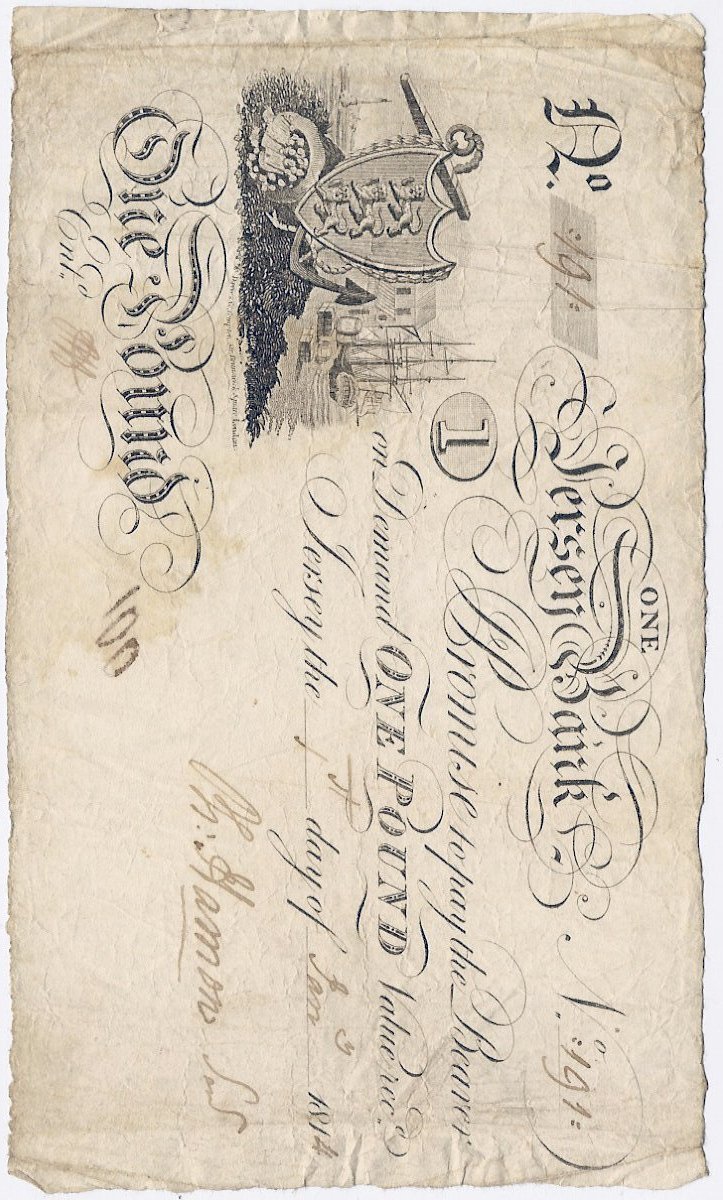
| Silver Tokens Production at a Glance |
|---|
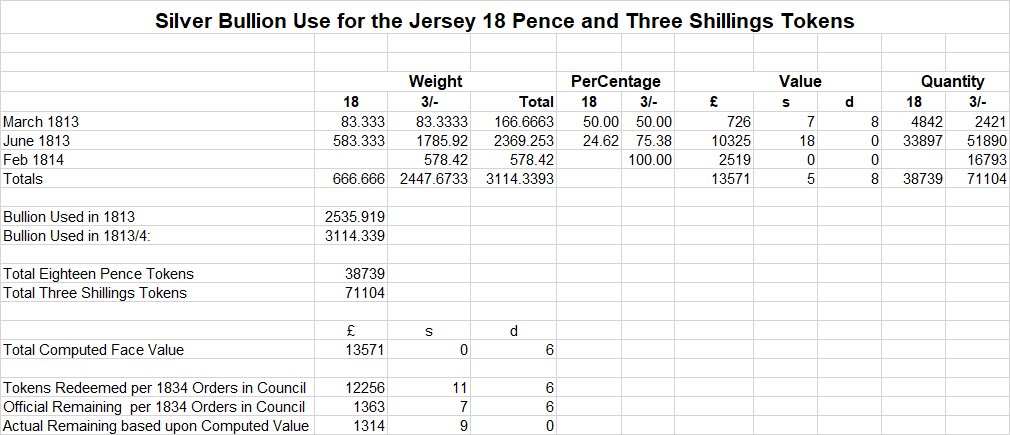 |
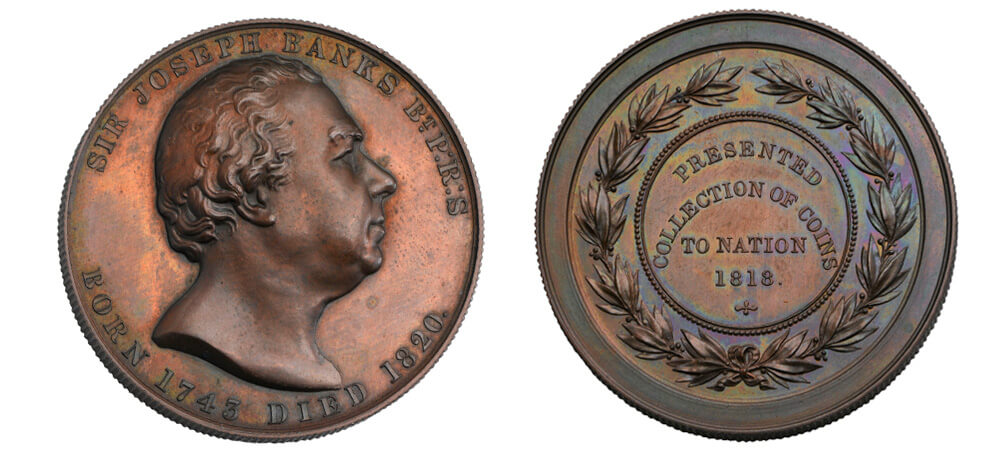
He was instrumental in warning the States of the potential of counterfeits. At this time, counterfeiting of silver coins was still a problem or as Greg Roberts writes in his blog "Wicked William Regency Blog inspired by the life and times of William-Pole-Tylney-Long-Wellesley (1788-1857)": ... Sir Joseph Banks, President of the Royal Society - a post he held for 42 years. The Royal Society traditionally exercised control over currency manufacture. The Mint comprised of disparate departments with strict, almost medieval, working practices. The Royal Society acted like a glue to keep these elements working together and to oversee innovation and improvement.
For a fun read, see
"Revisiting the Case of Joseph Hunton - Silver Token Issuer and Last Man Hanged for Forgery" by Gary Oddie.
|
| Eighteen Pence (click on image to enlarge) | |
|---|---|
 |
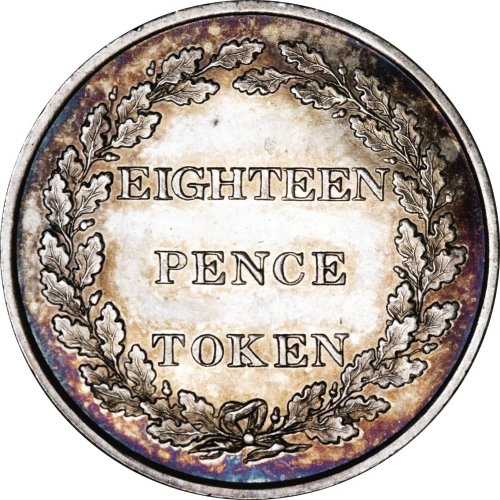 |
Year Mintage Diameter
1813 38,740 26.50 


Things to note:
| Three Shillings (click on image to enlarge) | |
|---|---|
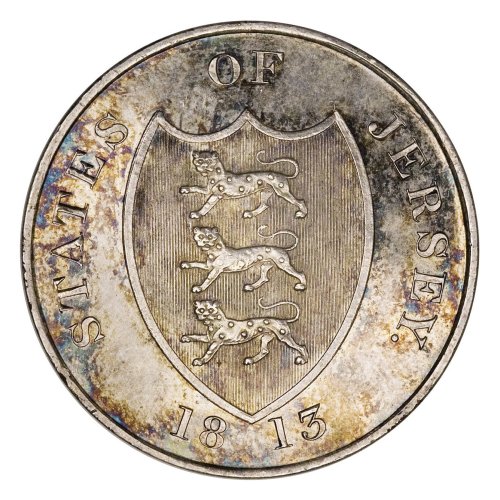 |
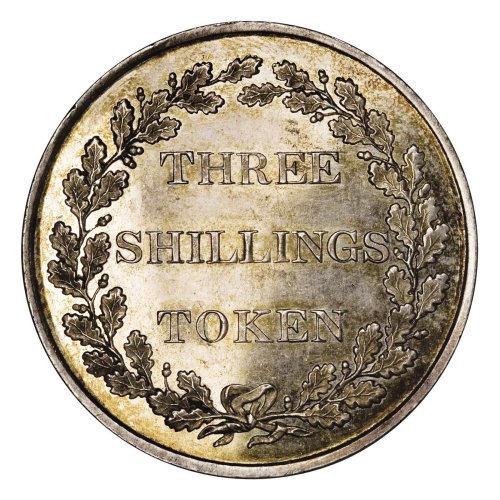 |
Year Mintage Diameter
1813 71,104 35.00 



Things to note:
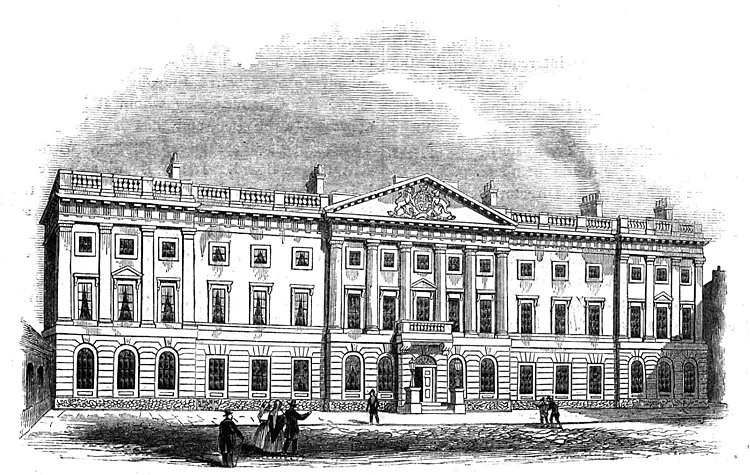
“The issue of the regal copper coinage of 1797 (known as that of the 'Soho' type), supplied a great want in the national currency; but the expensive warfare of the period, in which this country was engaged, enhanced the price of copper, and much of that heavy coinage, consisting of twopenny and penny pieces, consequently found its way to the smelting houses; while the value of the tokens of the eighteenth century becoming intrinsically enhanced, large quantities of the more honest description of those pieces also disappeared; and the spurious ones, being decried by authority, likewise found their way to the melting-pot. Thus another deficiency in the quantity of the copper currency soon arose. Eventually, however, the price of copper fell, and then this branch of trade came comparatively depressed, so that, about the year 1811, the large copper companies and other firms, seeing that the change in the value of the metal afforded a favorable opportunity for supplying the deficiency in the circulating medium, took advantage of the circumstance, and commenced striking and issuing a fresh series of provincial copper coins, such pieces constituting the nineteenth century series of tokens proper, as it may be termed.”According to some, the Jersey copper tokens were probably all private issues. Others think that these were patterns to be approved by the Island authorities. Depending on your source there are various different issues of penny tokens that circulated on the island. However everyone will agree that there is only one half penny token. As far as the tokens themselves, with the exception of the Prince of Wales Plumes / Jersey, Guernsey and Alderney combination penny, all Jersey copper tokens are very rare. (The Prince of Wales Plumes / Jersey, Guernsey and Alderney combination is just rare.) Things to note:
You can read in The Bazaar, the Exchange and Mart a nice description
of these Jersey tokens.
To learn more about 19th century British copper tokens in general, you need to the read the best book on the subject, British Copper Tokens 1811-1820, by Paul and Bente Withers. This book is fully illustrated and was written to set the standard. No numismatic library is complete without this book. |
| Prince of Wales Plumes / Jersey, Guernsey and Alderney Half Penny (click on image to enlarge) | |
|---|---|
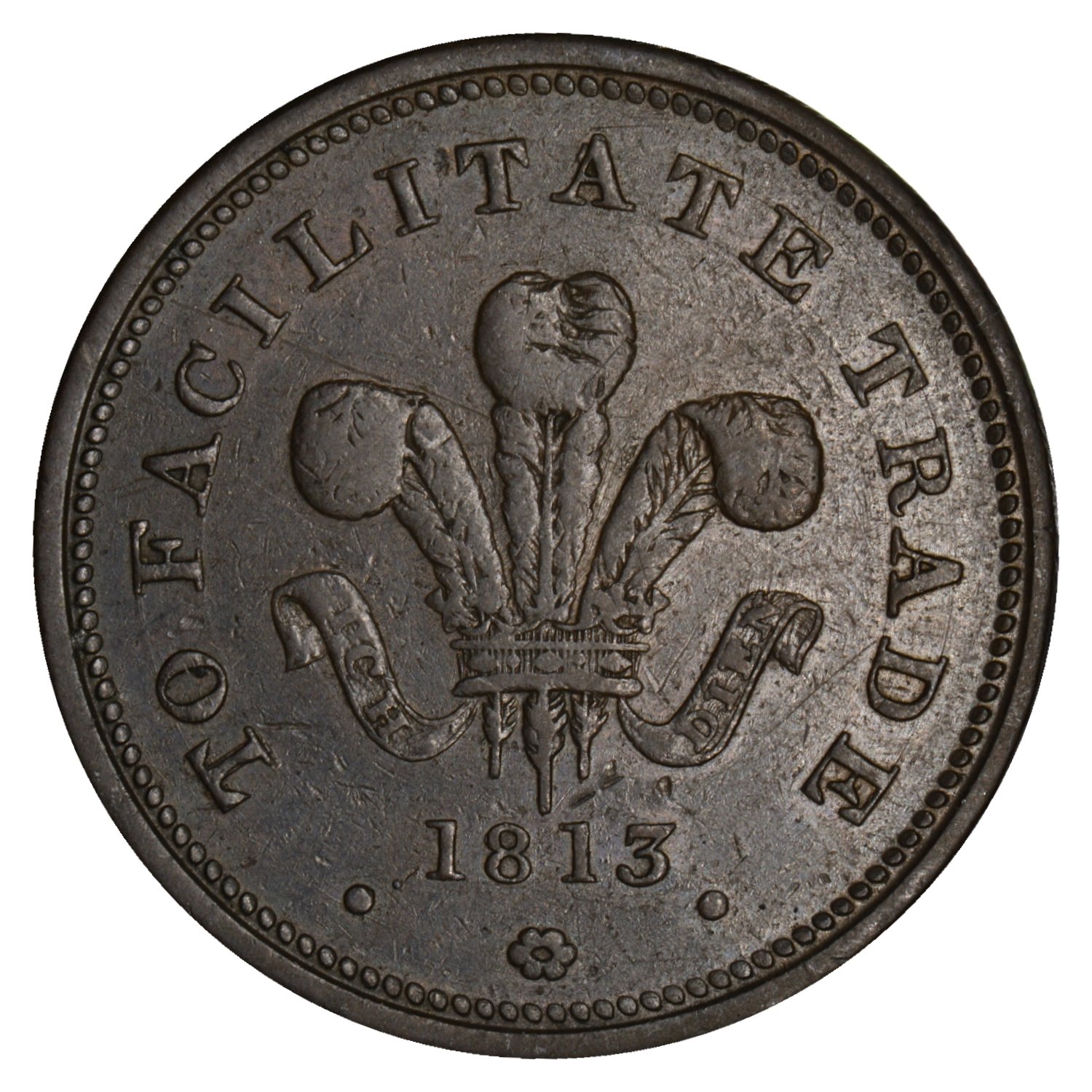 |
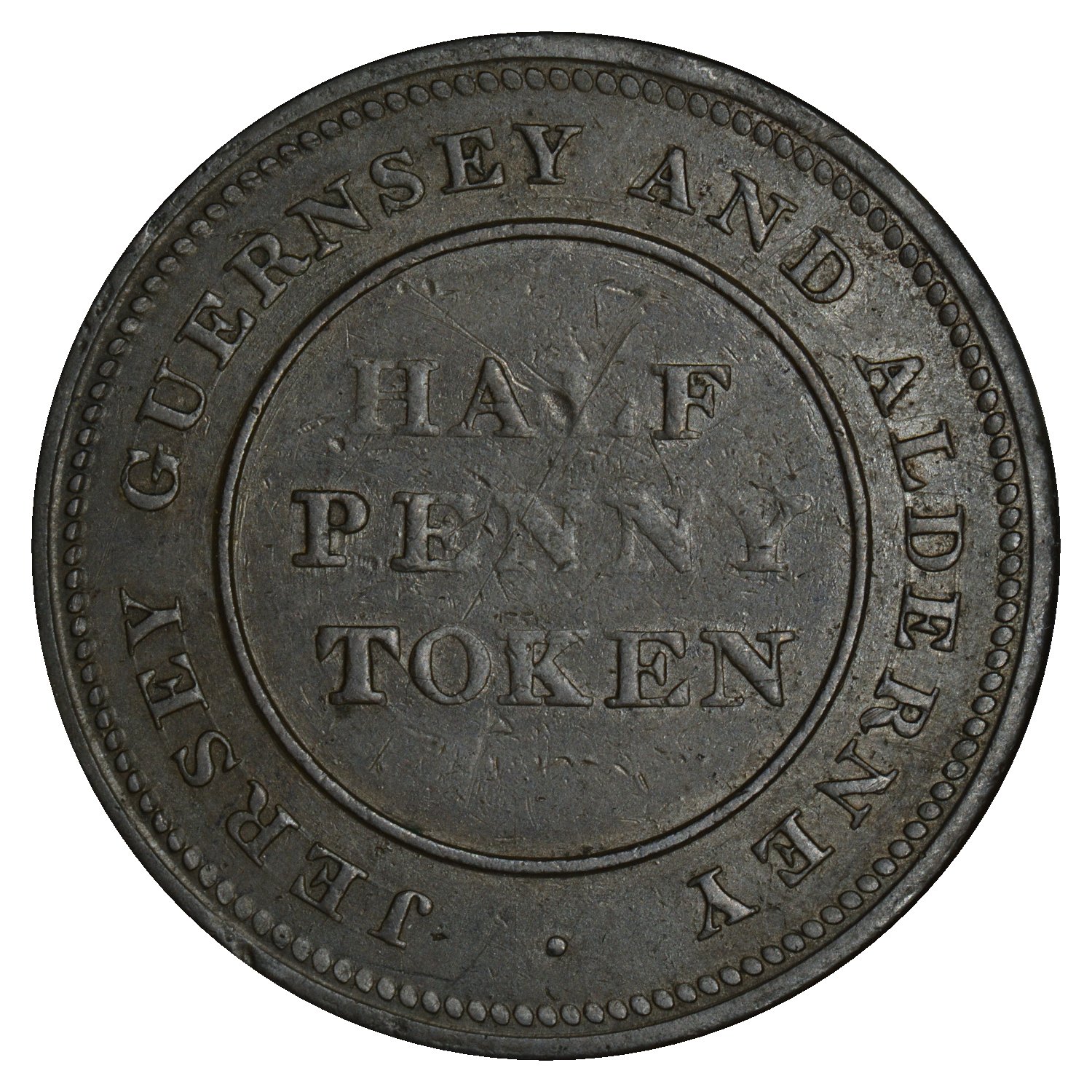 |
Year Withers Davis Pridmore McCammon Atkins
1813 W2050 241-14 63 T12 --- 

This token is a companion piece to the first penny token but is much rarer. Although this is not the rarest token, this is still the most sought after token of the
series.
From an article by A H Baldwin & Sons Ltd
concerning their historical "Baldwin Basement" stock:
“Of particular note is the collection formed by Francis S Cokayne who assembled an astounding number of tokens, probably the finest, and most extensive collection ever formed. He began collecting, along with his brother, Morton, in the late 1880s, had the pick of James Atkins' cabinet, traded regularly with many of the noted collectors of the period, and seems to have participated in every public token auction in the United Kingdom for over 50 years, either directly or through a representative (it was a standing rule at Baldwin's that staff could not leave on Friday until a new parcel of tokens was posted to Mr Cokayne's offices on Montagu Square). A number of the tokens in this auction can be further traced through him to William Norman, Frederick Lincoln, Samuel Hamer, Lionel Fletcher, William Davis, and, of course, James Atkins, among others."It is interesting to note that a similar piece was purchased by Mr Cokayne at the ex-Murdoch auction of 12/12/1904, LOT 209 for 5 pounds 15 shillings, which makes this one of the most expensive tokens he purchased.
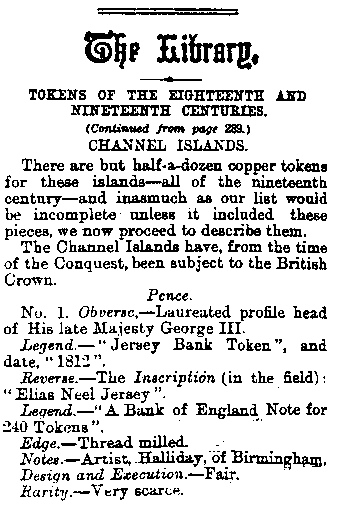
| The Various Configurations of the 1813/1814 Penny Tokens | ||||||
|---|---|---|---|---|---|---|
| Number | Withers1 | Davis2 | Pridmore3 | McCammon4 | Atkins5 | Rarity6 |
| 1 | 2044 | 241-10 | 62 | T6 | 49 | R / RR / RRR |
| 2 | 2043 | 241-7 | 65 | T5 | 52 | RRR |
| 3 | 2045 | 242-13 | 66 | T7 | 51 | RRR |
| 4 | 1636 | 241-8 | Rejected | T9 | RR | |
| 5 | 1681 | 242-12 | 68 | T10 | RR / RRR | |
| 6 | 2035 | 241-4 | 60 | T2 | 47 | |
| 7 | 2037 | 241-5 | 61 | T3 | 48 | |
| 8 | 2038 | |||||
| 9 | 2039 | RRR | ||||
| 10 | 2042 | 241-6 | 64 | T4 | 50 | |
| 11 | 1635 | 241-9 | Rejected | T11 | RRR | |
| 12 | 1680 | 241-11 | 67 | |||
| 13 | 1682 | 69 | T8 | RRR | ||
|
1 Withers, Paul and Bente, British Copper Tokens 1811-1820 2 Davis, W.J., The Nineteenth Century Token Coinage of Great Britain, Ireland, the Channel Islands and The Isle of Man, to which are added Tokens of Over One Penny Value of Any Period 3 Pridmore,F., The Coins of The British Commonwealth of Nations, Part 1 European Territories 4 McCammon, A.L.T., Currencies of the Anglo-Norman Isles 5 Atkins, James, The Coins and Tokens of The Possessions and Colonies of The British Empire 6 If more than one rarity scale is listed, minor varieties exists. Typically, this depends on the edge graining. Withers states the following as a rarity scale:
|
| The Various Configurations of the 1813/1814 Penny Tokens | ||||||||||||||
|---|---|---|---|---|---|---|---|---|---|---|---|---|---|---|
| Withers1 | Davis2 | Pridmore3 | McCammon4 | Atkins5 | Rarity6 | |||||||||
| 1635 | 241-9 | Rejected | T11 | RRR | ||||||||||
| 1636 | 241-8 | Rejected | T9 | RR | ||||||||||
| 1680 | 241-11 | 67 | ||||||||||||
| 1681 | 242-12 | 68 | T10 | RR / RRR | ||||||||||
| 1682 | 69 | T8 | RRR | |||||||||||
| 2035 | 241-4 | 60 | T2 | 47 | ||||||||||
| 2037 | 241-5 | 61 | T3 | 48 | ||||||||||
| 2038 | ||||||||||||||
| 2039 | RRR | |||||||||||||
| 2042 | 241-6 | 64 | T4 | 50 | ||||||||||
| 2043 | 241-7 | 65 | T5 | 52 | RRR | |||||||||
| 2044 | 241-10 | 62 | T6 | 49 | R / RR / RRR | |||||||||
| 2045 | 242-13 | 66 | T7 | 51 | RRR | |||||||||
|
1Withers, Paul and Bente, British Copper Tokens 1811-1820 2Davis, W.J., The Nineteenth Century Token Coinage of Great Britain, Ireland, the Channel Islands and The Isle of Man, to which are added Tokens of Over One Penny Value of Any Period 3Pridmore,F., The Coins of The British Commonwealth of Nations, Part 1 European Territories 4McCammon, A.L.T., Currencies of the Anglo-Norman Isles 5Atkins, James, The Coins and Tokens of The Possessions and Colonies of The British Empire 6 If more than one rarity scale is listed, minor varieties exists. Typically, this depends on the edge graining. Withers states the following as a rarity scale:
| ||||||||||||||
| Some of the Die Pairings for the One Penny Tokens |
|---|
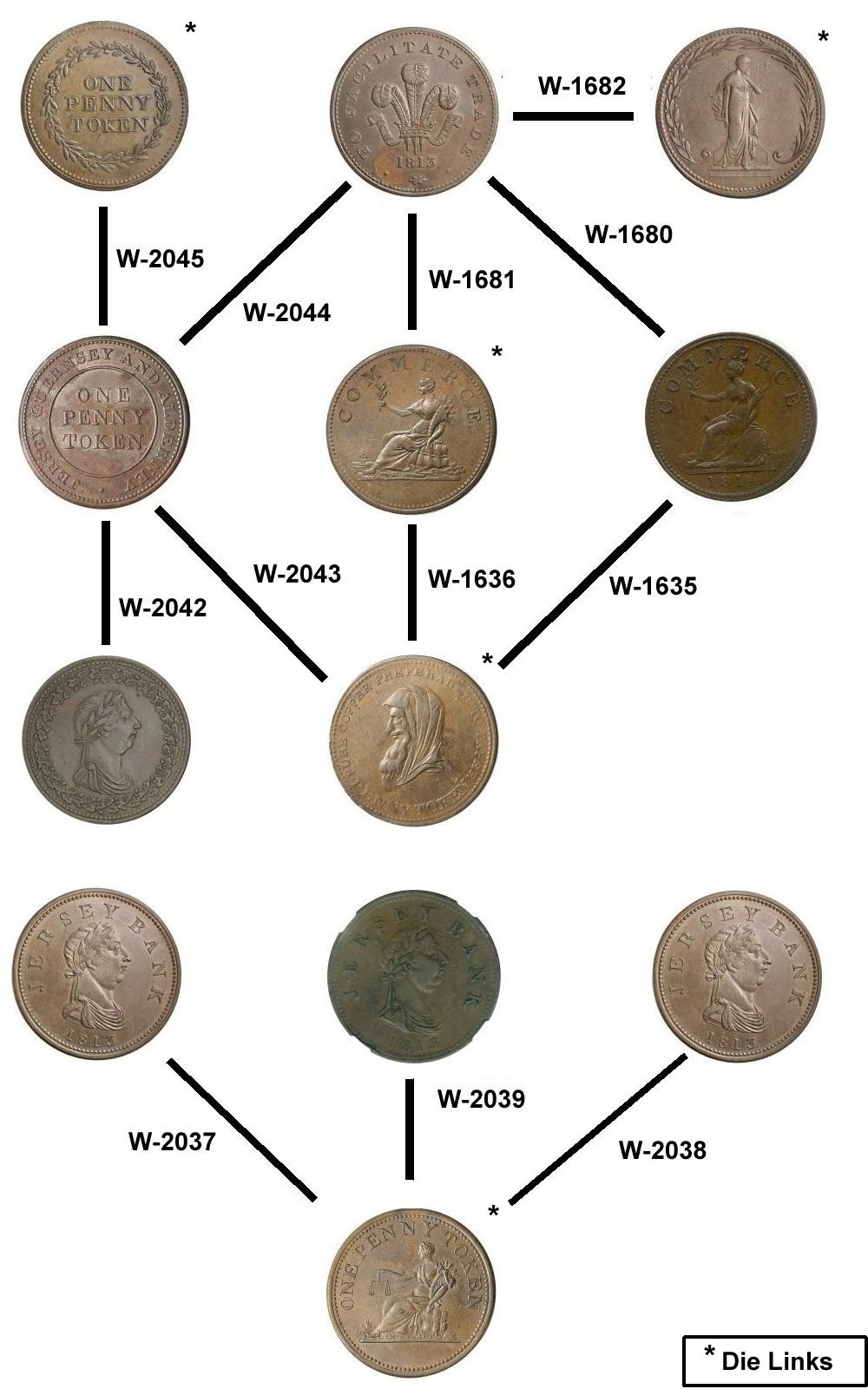 |
| Some of the Die Pairings for the One Penny Tokens |
|---|
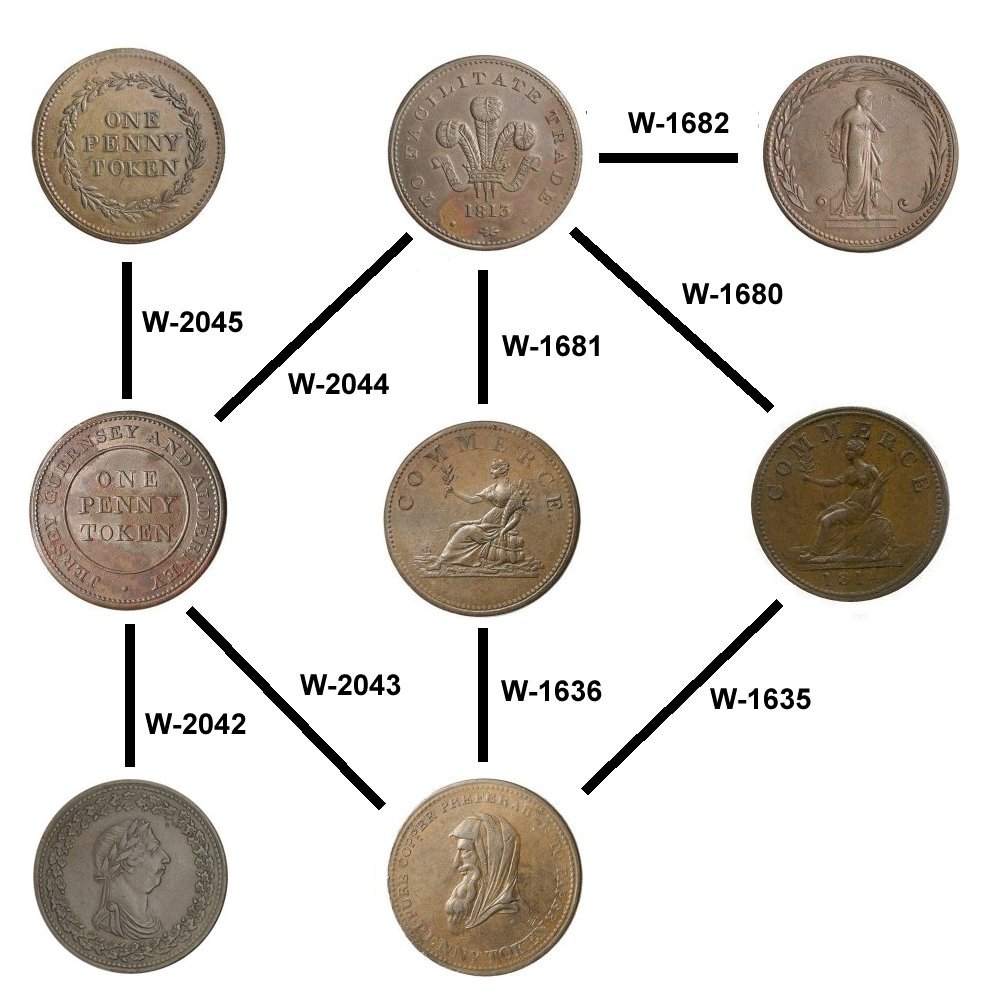 |
| Some of the Die Pairings for the One Penny Tokens |
|---|
 |
| Druid / 1814 Commerce Penny Token (click on image to enlarge) | |
|---|---|
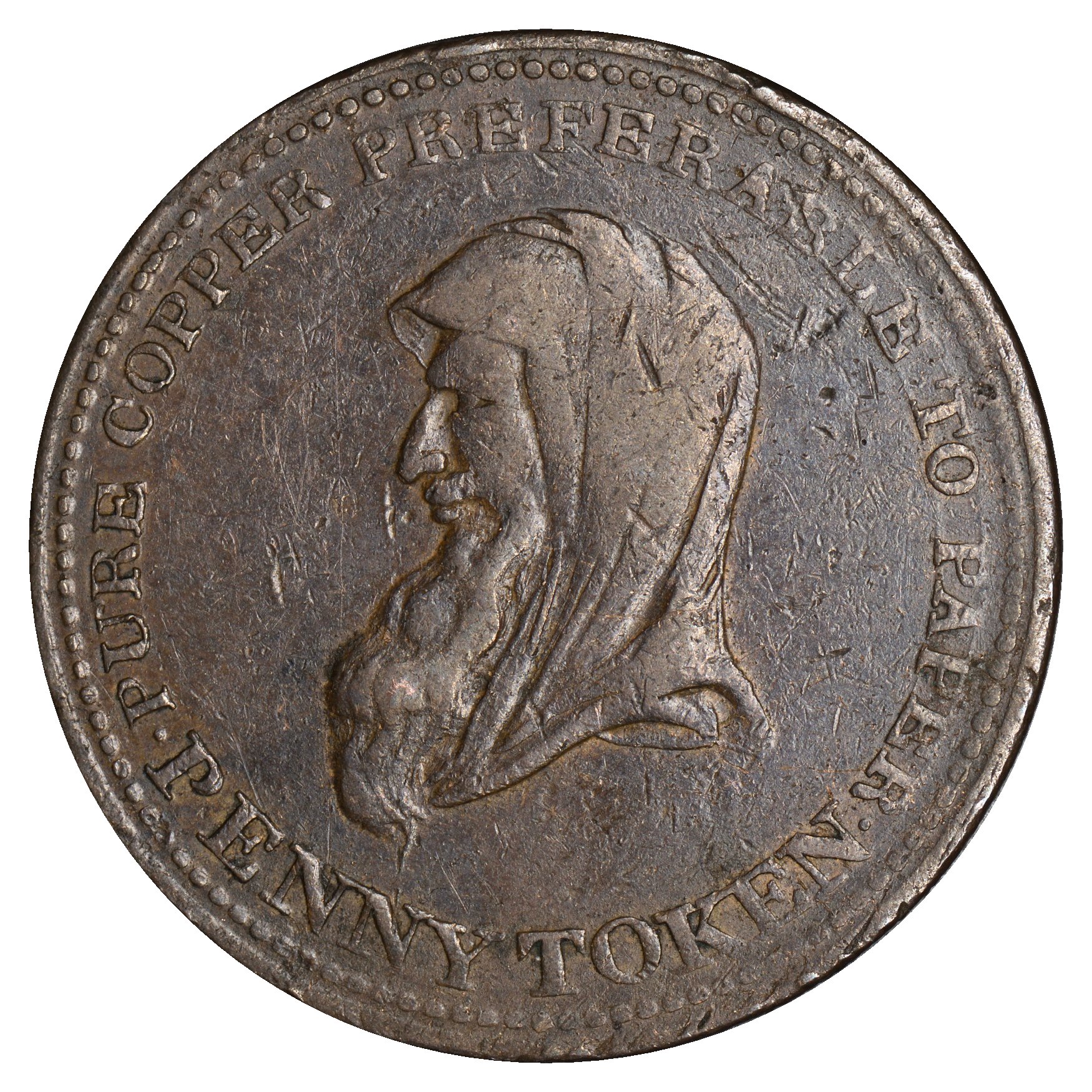 |
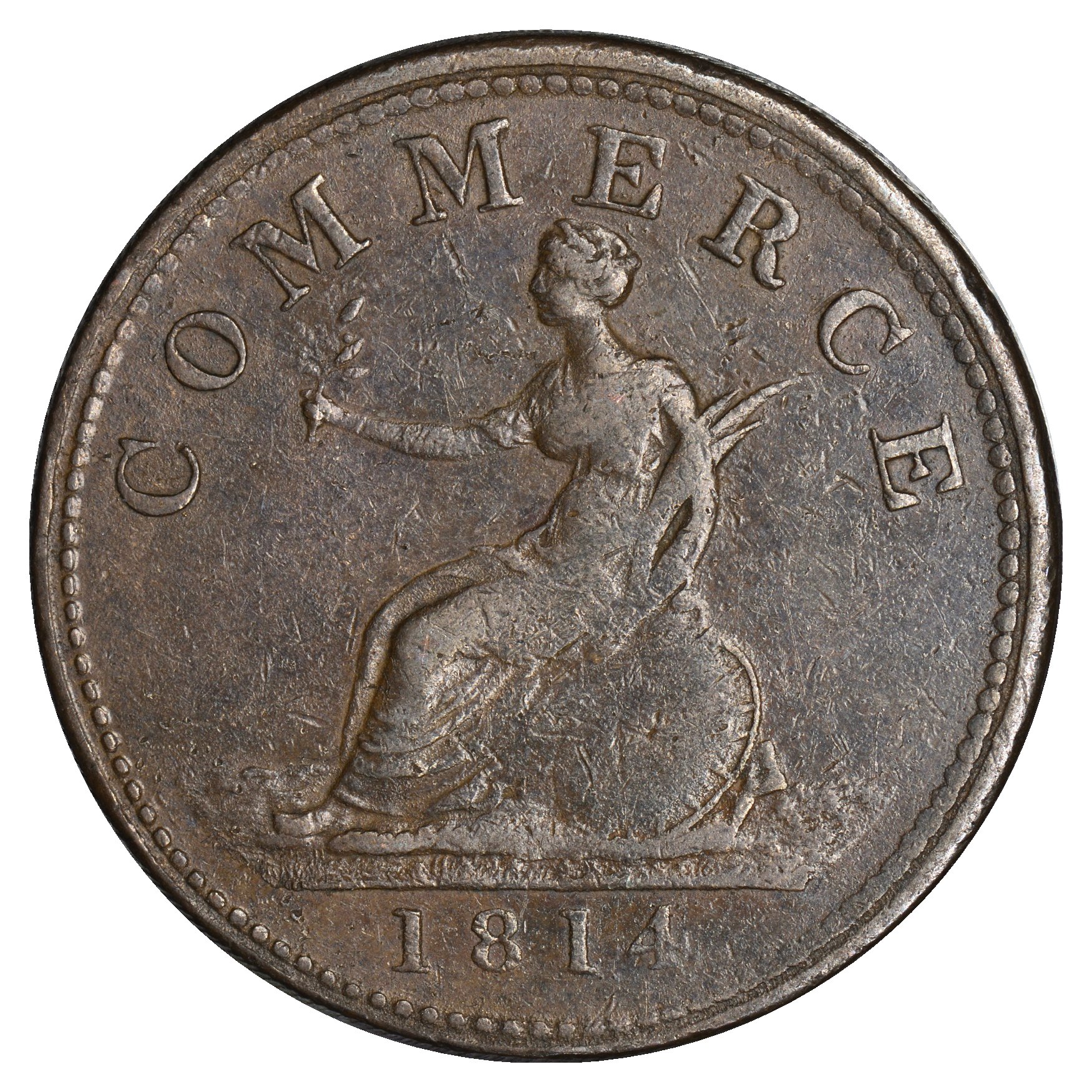 |
Year Withers Davis Pridmore McCammon Atkins
1814 W1635 241-9 Rejected T11 --- 
This token has a druid's head on the obverse.
The reverse depicts a robed female figure, Britannia.
She is seated to the left on a bale of merchandise, holding in her right hand a sprig of olive, and in her left a palm branch.
A shield is at her side.
The legend is “COMMERCE” and in the exergue is the date 1814.
Halliday engraved this die.
| Druid / Commerce Penny Token (click on image to enlarge) | |
|---|---|
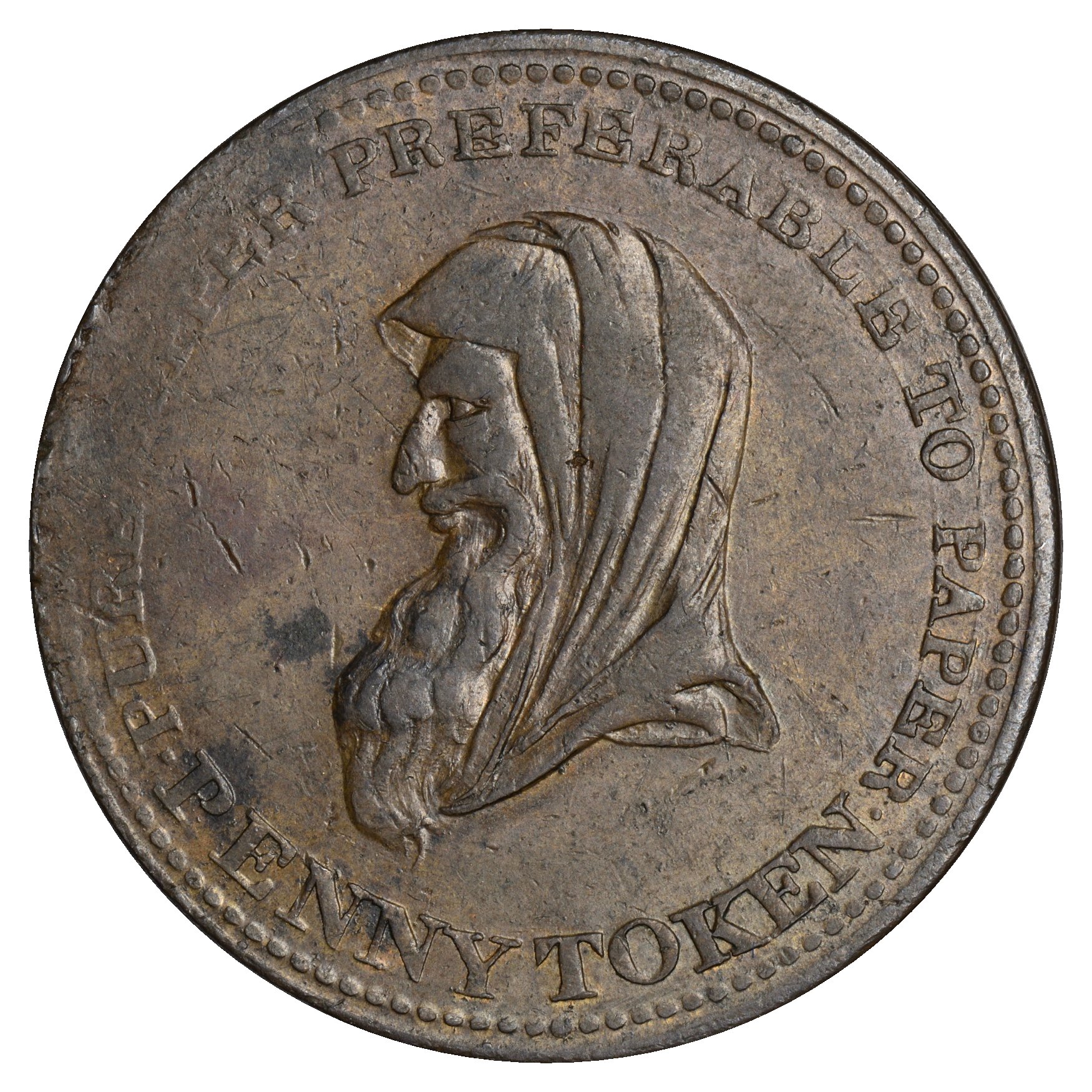 |
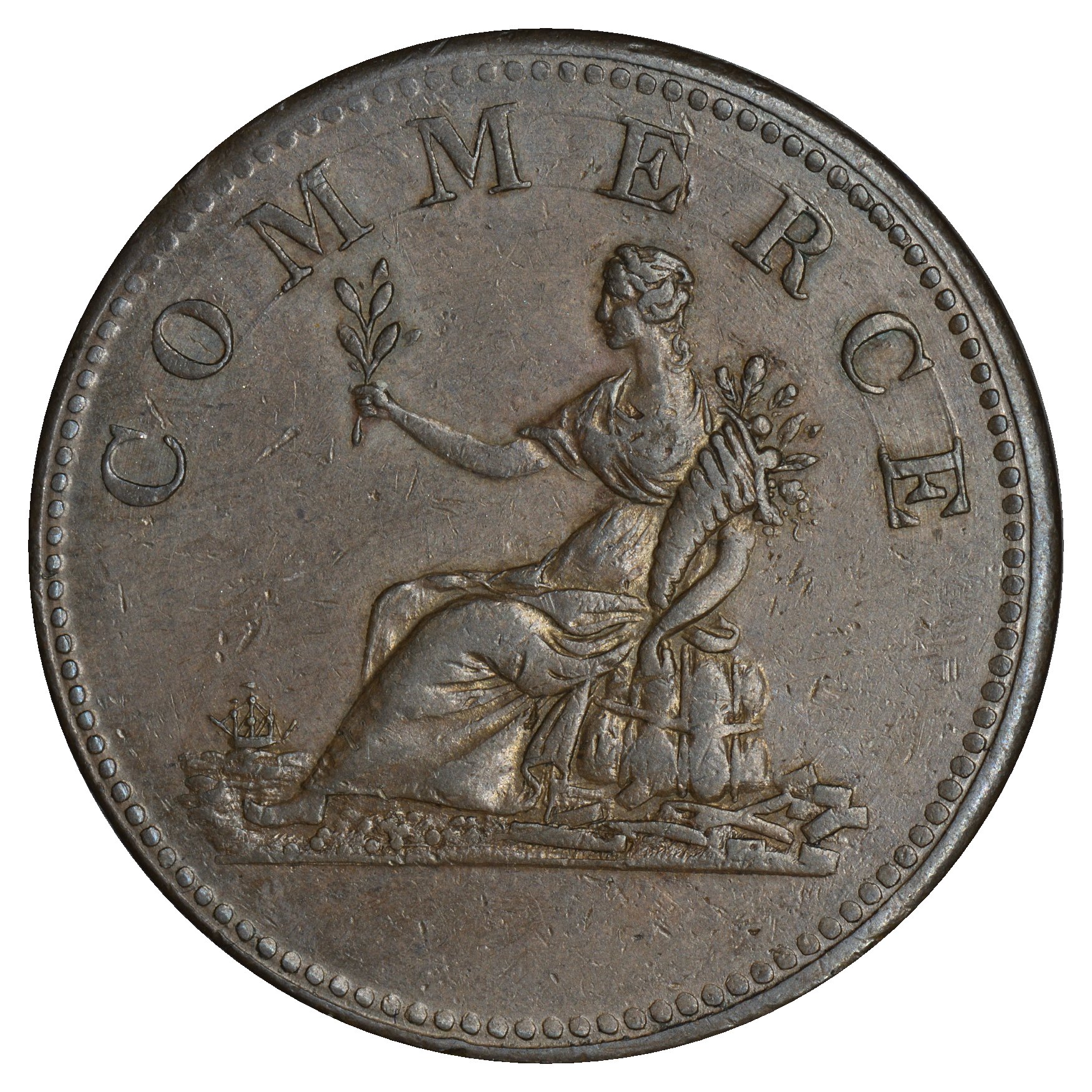 |
Year Withers Davis Pridmore McCammon Atkins
1813 W1636 241-8 Rejected T9 ---
The obverse of this token also has the druid design as seen on W1635.
The reverse has a female seated on a bale of merchandise holding an olive branch in her right hand and a cornucopia in her left.
The cornucopia represents abundance, wealth, and prosperity while the olive branch is a symbol of peace.
In the distance, a ship can be seen.
There are various examples known to have been struck over Jersey Bank tokens.
Withers rates this as a RR token. The obverse die links with both the W642 and W646 Burton tokens. The reverse die links with the W1616 Non-Local token. |
| Prince of Wales Plumes / Commerce with Cornucopia Penny Token (click on image to enlarge) | |
|---|---|
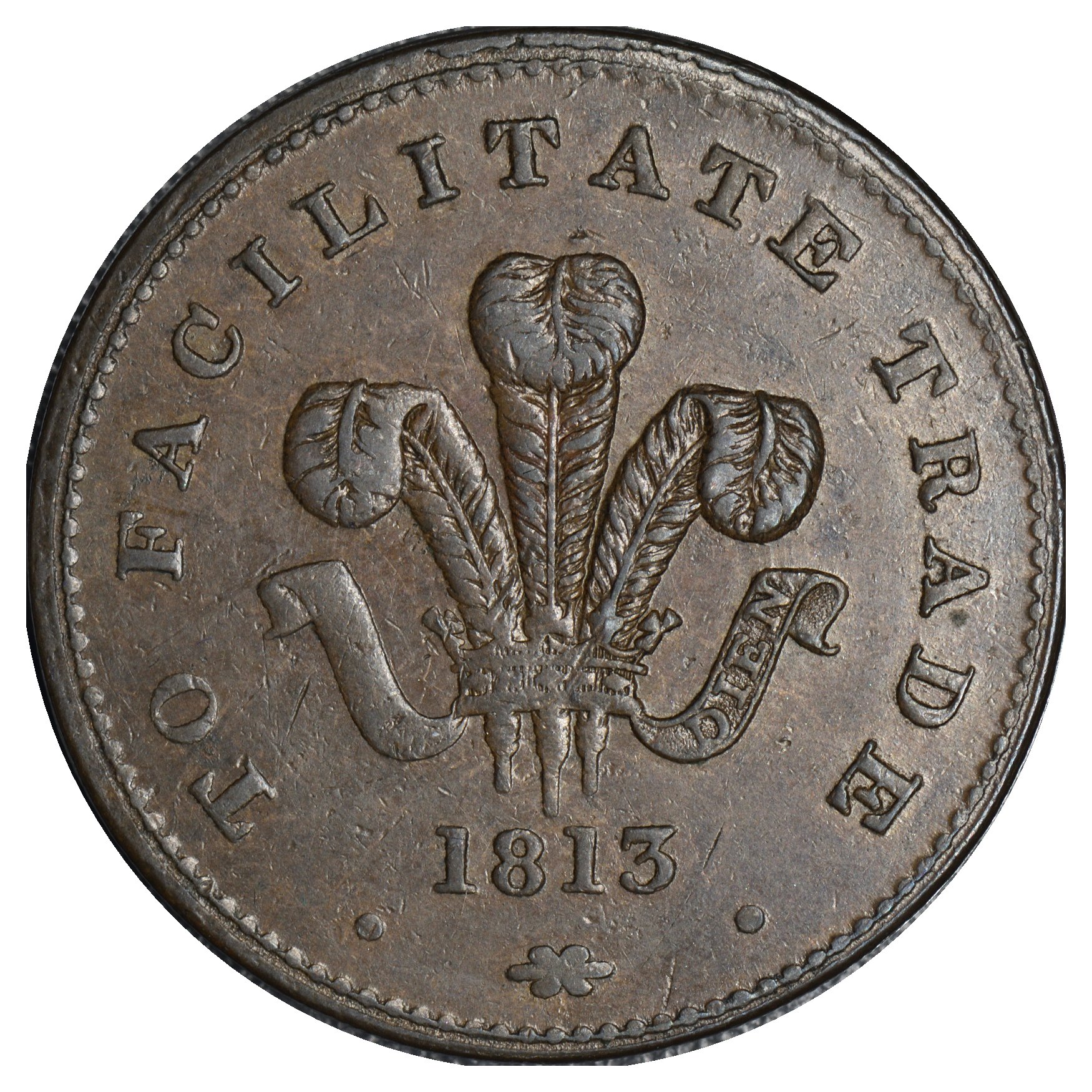 |
 |
Year Withers Davis Pridmore McCammon Atkins
1813/4 W1680 242-11 67 --- ---
This token's obverse has the Prince of Wales' feathers emerging from a coronet.
The motto on the ribbon is “ICH DIEN” and under the crest is the date 1813.
The legend is “TO FACILITATE TRADE.”
Like most of the other Jersey copper tokens of this period, they were engraved by Thomas Halliday,
a
die engraver and token manufacturer of Newhall Street and Hagley Row, Birmingham, England.13
This design seems to be a favorite design of his, given the fact that he used it on several English tokens of this same period.
The reverse is the same as W1635.
| Prince of Wales Plumes / Commerce Penny Token (click on image to enlarge) | |
|---|---|
 |
 |
Year Withers Davis Pridmore McCammon Atkins
1813 W1681 242-12 68 T10 --- 

This token is another rare mule token, that depicts the Price of Wales's badge.
The reverse has the same design as W1636.
Thomas Halliday also worked for the Messrs. Morgan & Company, Die Makers, Medallists and Token Manufacturers.
Mr. Henry Morgan advertised in the newspapers of the day and it is quite likely these copper tokens were ordered through
and supplied by the Morgan firm, but possibly were “handled” by Thomas Halliday.
You can read more about Mr. Morgan entrepreneurship in James O'Donald Mays' book, Tokens of Those Trying Times.
| Prince of Wales Plumes / Justice Penny Token (click on image to enlarge) | |
|---|---|
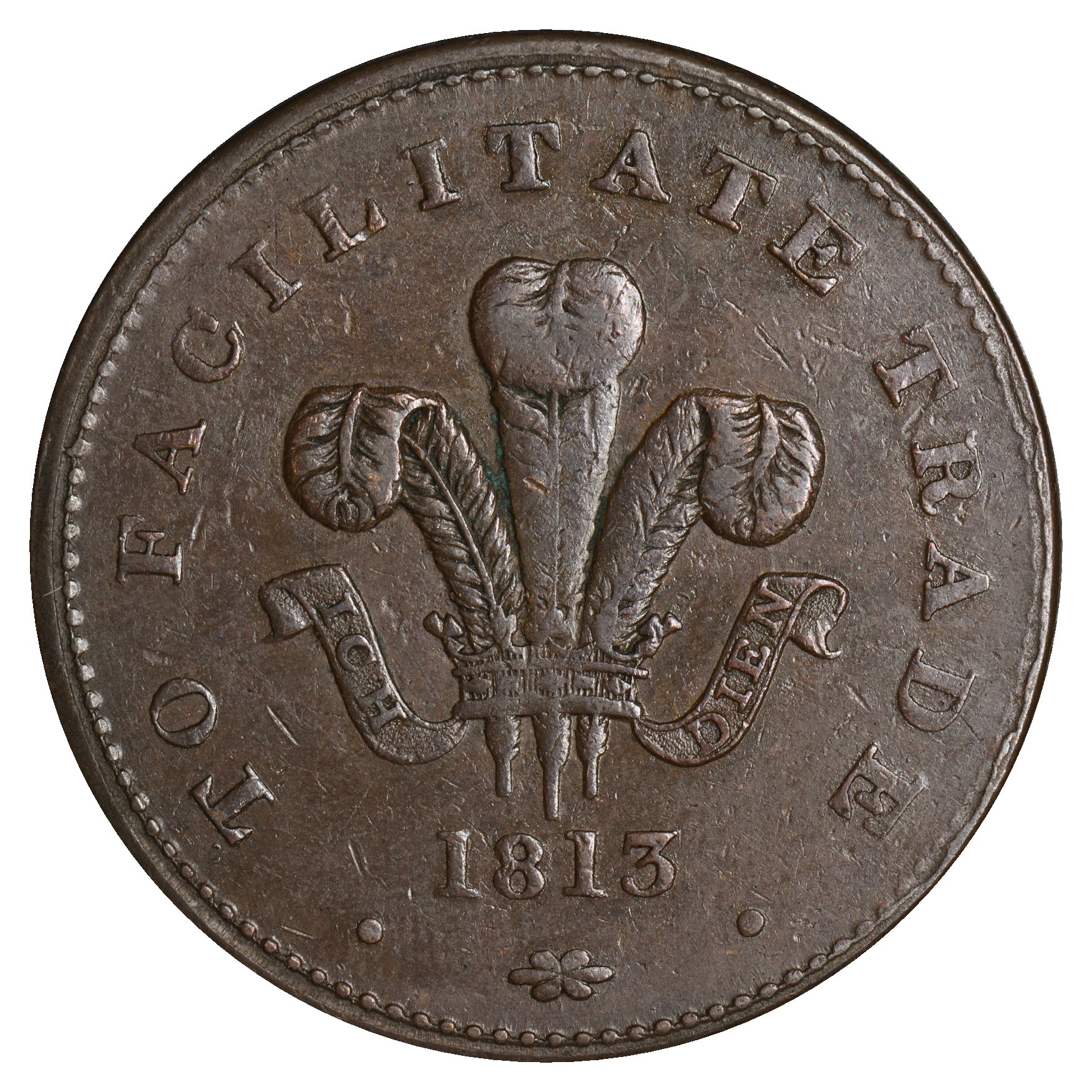 |
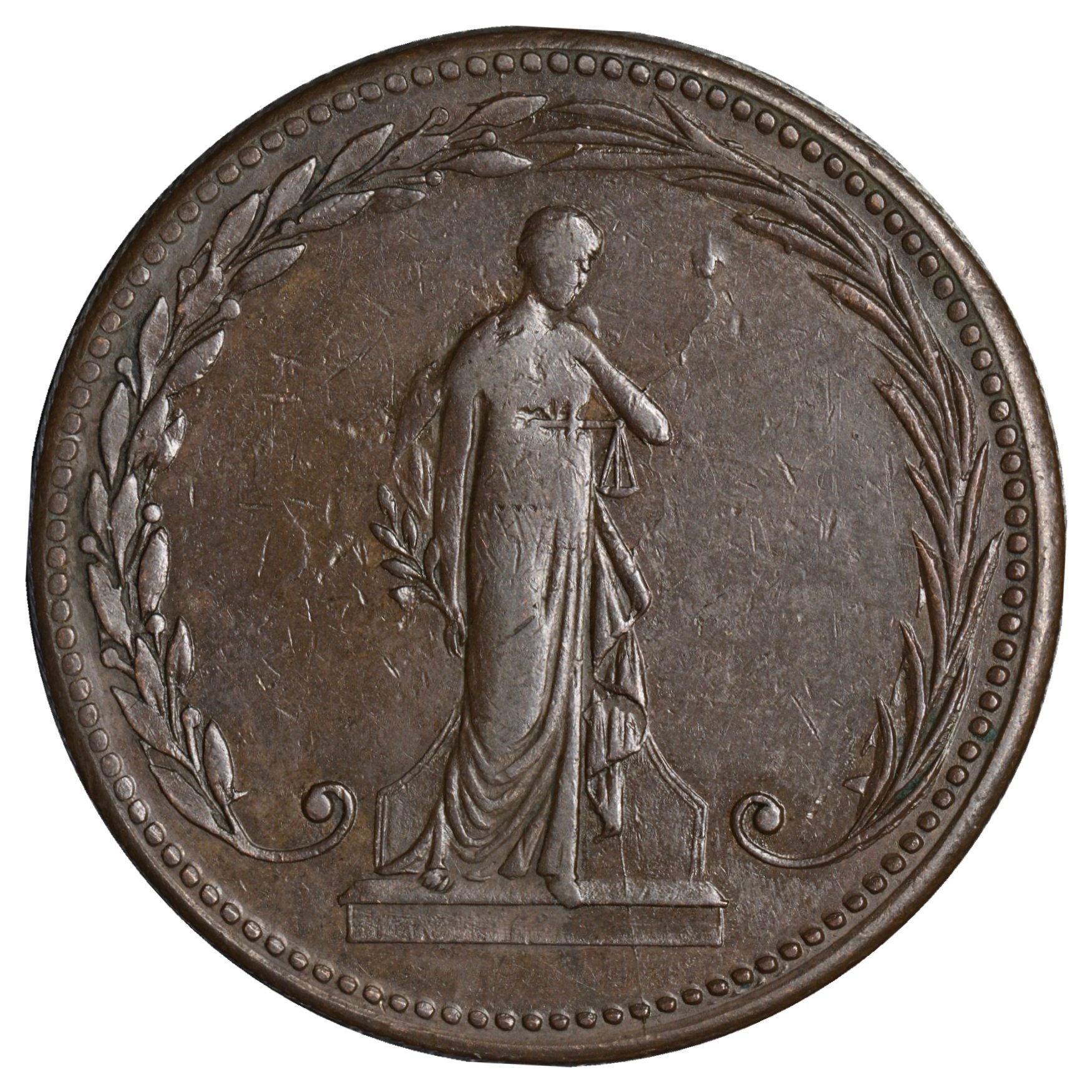 |
Year Withers Davis Pridmore McCammon Atkins
1813 W1682 --- 69 T8 ---
The obverse is similar to the first token with the Prince of Wales' design.
The reverse of this token has a female, Lady Justice, standing wearing a toga.
She is holding an olive branch and scales within a wreath of olive and palm branches.
The palm branch, or palm frond, is a symbol of victory, triumph, peace, and eternal life.
The olive branch is a symbol of peace.
Withers list this as RRR. The reverse die links to the W1615 Non-Local token. |
| Elias Neel Jersey Penny Token |
|---|
Year Withers Davis Pridmore McCammon Atkins
1812 W2035 241-4 60 T2 47
Withers 2035 is the holy grail of Jersey tokens. According to various sources, the obverse has a profile of George III laureated.
The legend reads as “JERSEY BANK TOKEN 1812.” The reverse has in the center
“ELIAS NEEL JERSEY.” The legend is “A BANK OF ENGLAND NOTE FOR 240 TOKENS.”
Elias Neel, a banker in St. Helier, issued this token.
The die sinker of the token was Halliday while the manufacturer was Thomason.14
Unfortunately, this token has not been seen since 1834.
For a nice article about this token see Elias Neel
Jersey Bank Token of 1812 by Hugh Pagan.15
(This and other nice reads can be found on the British Numismatic Society Research Blog.)
| Jersey Bank Penny Token (click on image to enlarge) |
|---|
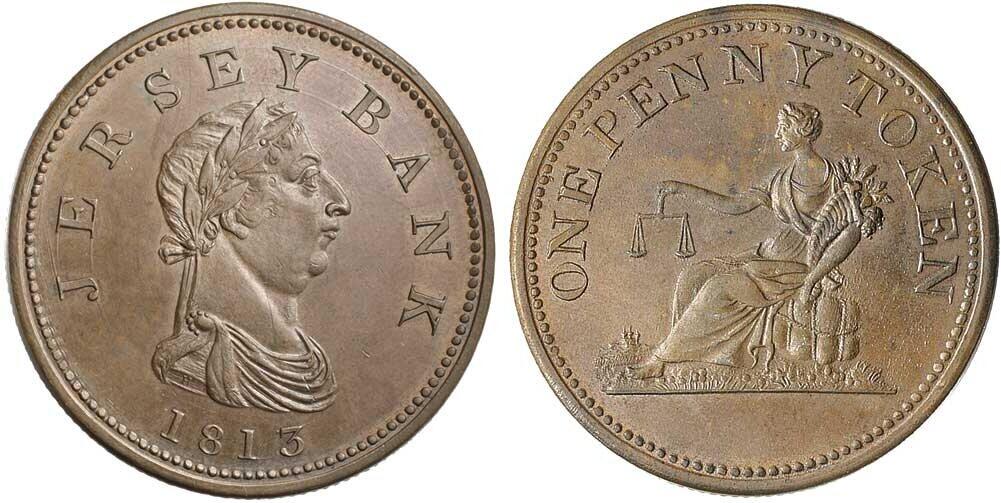 |
Year Withers Davis Pridmore McCammon Atkins
1813 W2037 241-5 61 T3 48
The obverse has a draped and laureated bust to the right of George III, with an H on the truncation.
The legend is simply “JERSEY BANK 1813.” Halliday engraved this die.
On the reverse there is a robed female figure seated to the left on a bale, holding scales and a cornucopia.
Typical of these coins, the female represents Justice and Plenty.
The legend is “ONE PENNY TOKEN.”
| Jersey Bank Penny Token |
|---|
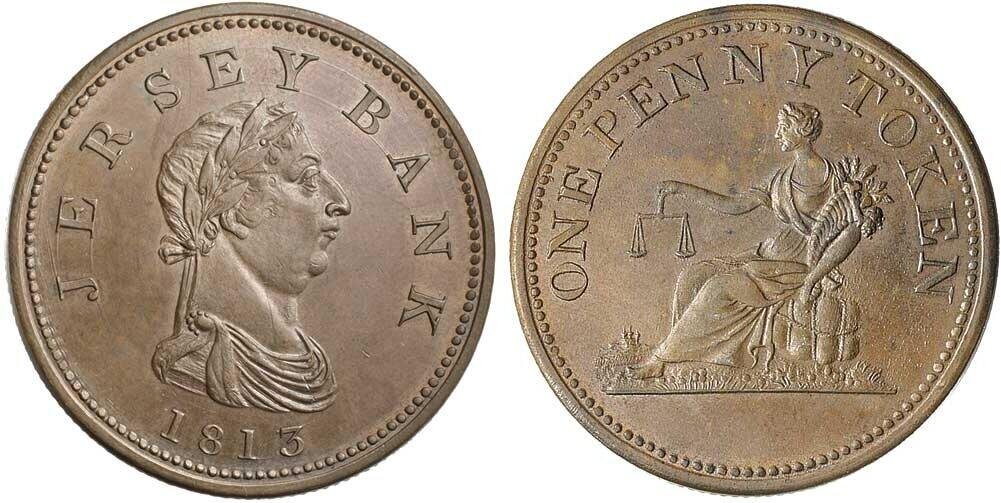 |
Year Withers Davis Pridmore McCammon Atkins
1813 W2038 --- --- --- ---
I do not have an actual picture of this token, but it is very similar to W2037.
The difference is there is not an H on the truncation.
| Jersey Bank Penny Token Image Courtesy of Philip Warrington (click on image to enlarge) | |
|---|---|
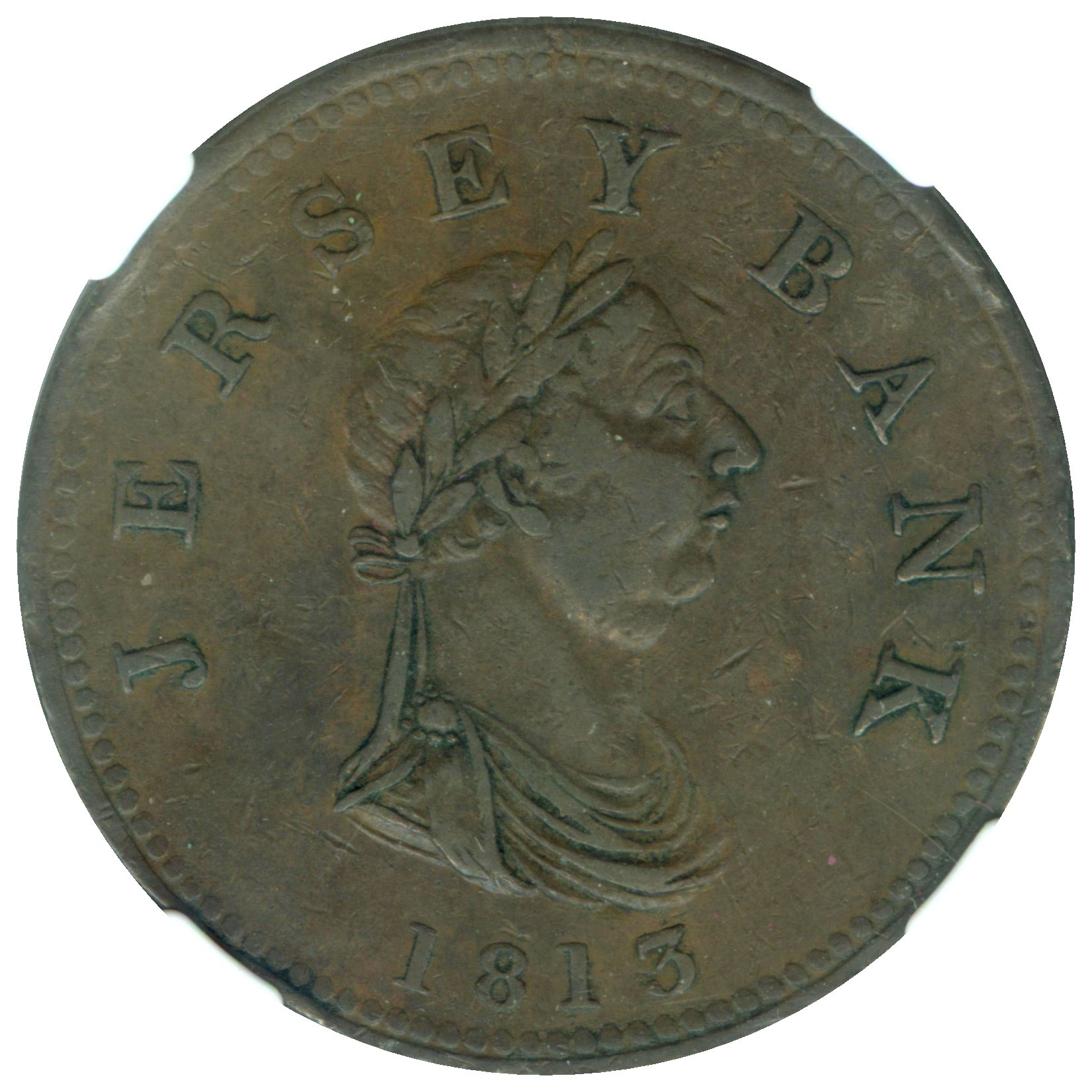 |
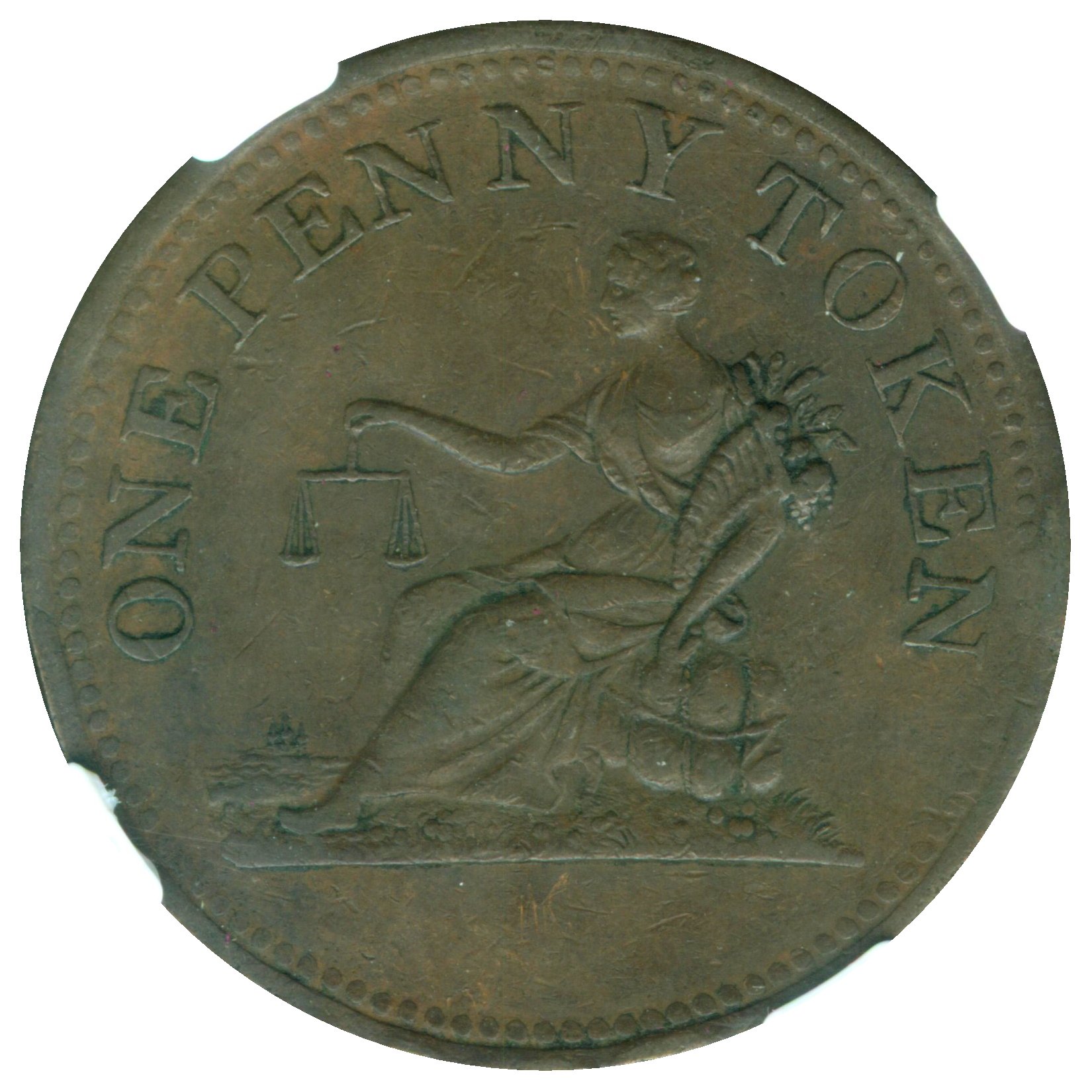 |
Year Withers Davis Pridmore McCammon Atkins
1813 W2039 --- --- --- ---
The obverse also has a draped and laureated bust of George III to the right, with no H on truncation.
There are nine leaves in the wreath.
The legend reads “JERSEY BANK 1813.” This die was also engraved by Halliday.
The reverse is the same as the previous two tokens.
| George III within Wreath / Jersey, Guernsey and Alderney Penny Token (click on image to enlarge) | |
|---|---|
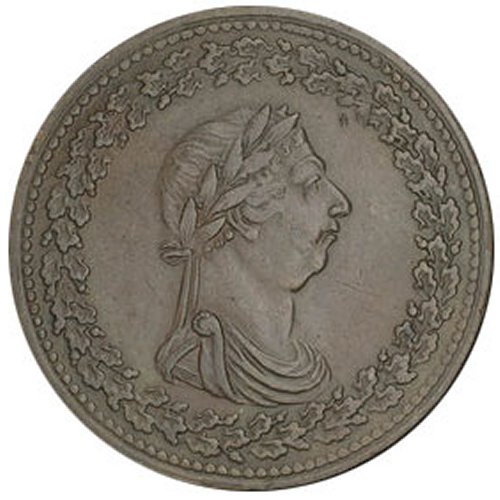 |
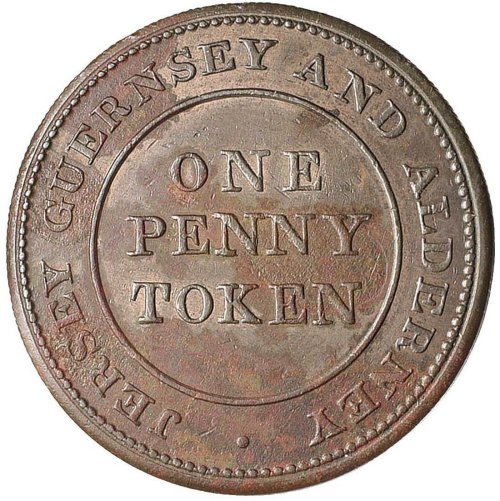 |
Year Withers Davis Pridmore McCammon Atkins
1813 W2042 241-6 64 T4 50
The obverse on this token has a laureated and draped bust to the right of George III, within a wreath of oak.
Once again, the die was engraved by Halliday.
The reverse is similar to the Jersey, Guernsey and Alderney tokens.
Note that the obverse image for this token I used, might not be correct!
Like Withers, I am unable to locate this token, but I believe this die is the same one used on an 1812 Lower Canada token.
| Druid / Jersey, Guernsey and Alderney Penny Token (click on image to enlarge) | |
|---|---|
 |
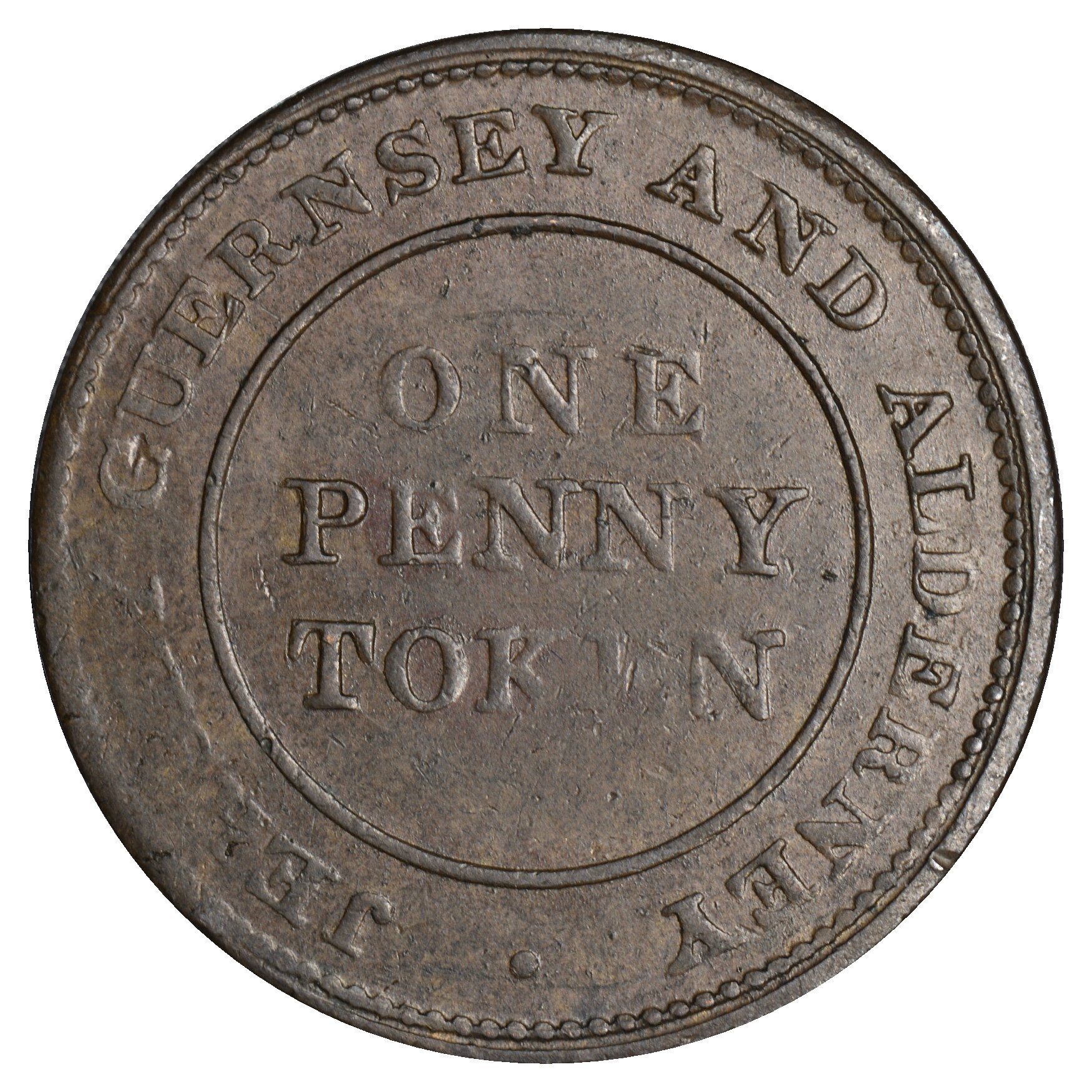 |
Year Withers Davis Pridmore McCammon Atkins
1813 W2043 241-7 65 T5 52 
Here we have a token muled together with the Druid's head and the Jersey/Guernsey and Alderney dies.
During this time copper was thought to be a good investment and there was a distrust of paper.11
If you are familiar with late 18th century tokens, then you are aware that the druid's head was a popular design.
Ken Elks states, “This design can be traced to the Parys Mines Company. Starting in 1787, this company
manufactured a penny, halfpenny and farthing tokens,
primarily to pay their workers at their copper mines on the Isle of Anglesey. These tokens
all bore the veiled head of a druid on the obverse and their cipher PMCo on the reverse.
These were some of the first tokens produced in the largest numbers,
some 250 tons of pennies and 50 tons of halfpennies. The farthings were only issued in
relatively small numbers. Some of the later tokens with different reverse designs were
concoctions made especially for collectors. All the coins were manufactured at a private mint
set up in Birmingham, owned by the Parys Mines Company.”12
| Prince of Wales Plumes / Jersey, Guernsey and Alderney Penny Token (click on image to enlarge) | |
|---|---|
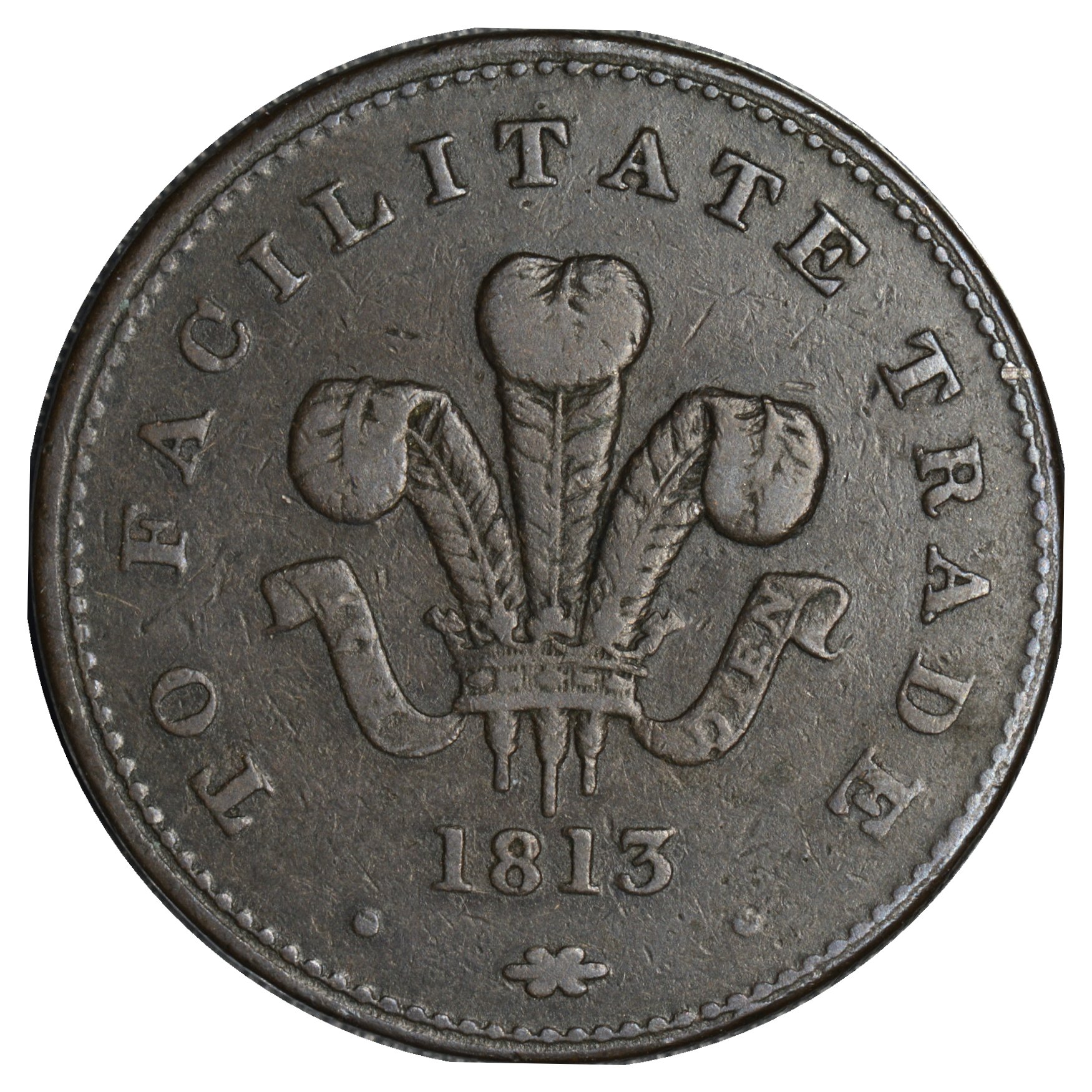 |
 |
Year Withers Davis Pridmore McCammon Atkins
1813 W2044 241-10 62 T6 49 


This token is the easiest token in the series to locate but is still considered rare.
The obverse has the familiar Badge of the Prince of Wales.
The slogan “TO FACILITATE TRADE” was used to encourage circulation.11
The reverse is simply the inscription “ONE PENNY TOKEN” in three lines with the legend
“JERSEY GUERNSEY AND ALDERNEY.”
The diesinker was Thomas Halliday, the most famous diesinker of the early nineteenth century British copper tokens.
There are several different minor varieties depending on the graining of the edge and die orientation.
Another variety has a rusted reverse die.
| Wreath / Jersey, Guernsey and Alderney Penny Token (click on image to enlarge) | |
|---|---|
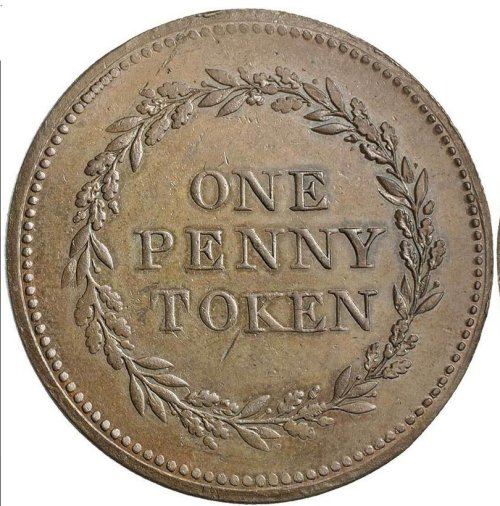 |
 |
Year Withers Davis Pridmore McCammon Atkins
1813 W2045 242-13 66 T7 51
The obverse has the
inscription “ONE PENNY TOKEN” in three lines inside an oak wreath.
Various sources do not seem to agree as the engraver of the dies.
Since there is a small H on the leaf opposite of the N in TOKEN, it would appear that the engraver is Halliday.
Unfortunately, it is often difficult to see this tiny H.
The reverse is similar to the previous token.
Also note that the spelling of Guernsey is the English version as opposed
to the French Guernesey. The French spelling, Guernesey, was found on their coins from 1830 through 1949.
Another RRR token. The obverse die links with the W640 Burton, W935 Nottingham, and W1616 Non-Local tokens. |
| Flint Copper Company Overstruck on Jersey Bank Penny Token Image Courtesy of Philip Warrington (click on image to enlarge) | |
|---|---|
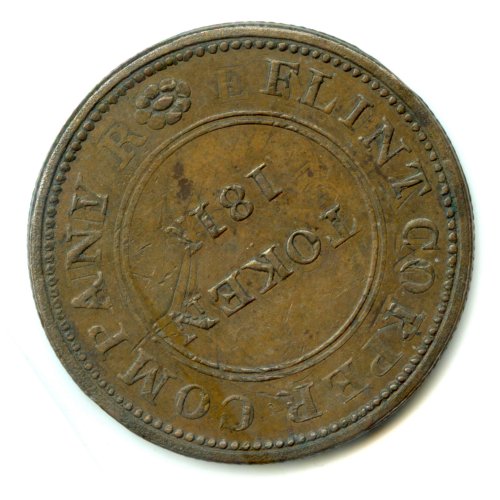 |
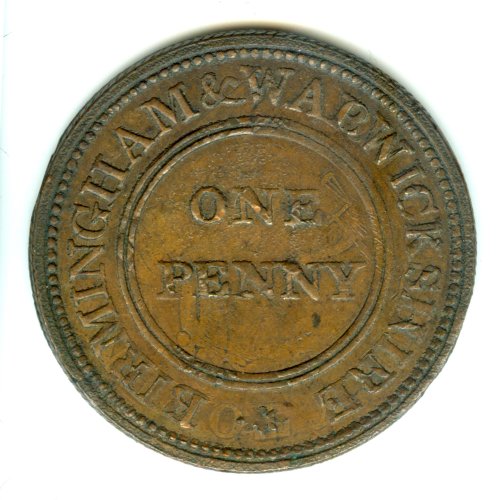 |
| Burton Overstruck on Jersey Bank Penny Token Image Courtesy of Philip Warrington (click on image to enlarge) | |
|---|---|
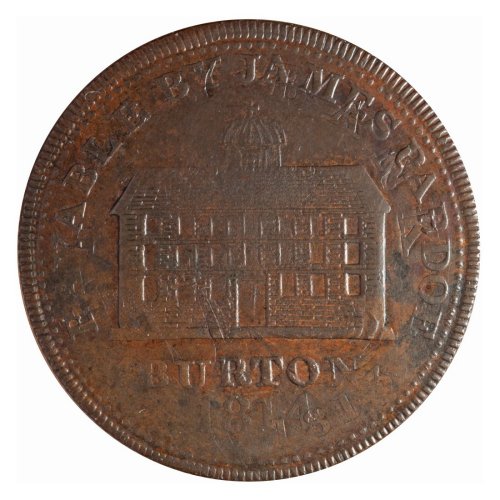 |
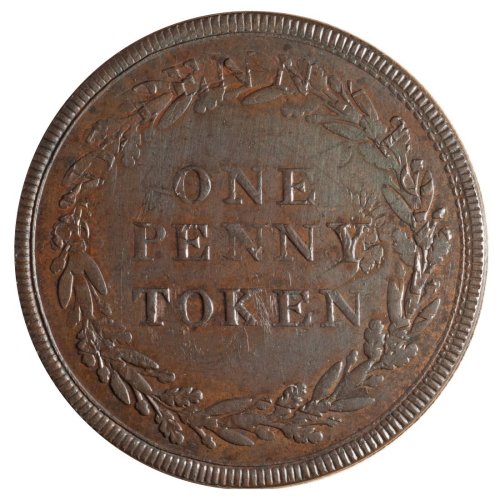 |
| Sedbury Iron Works Overstruck on Jersey Bank Penny Token (click on image to enlarge) | |
|---|---|
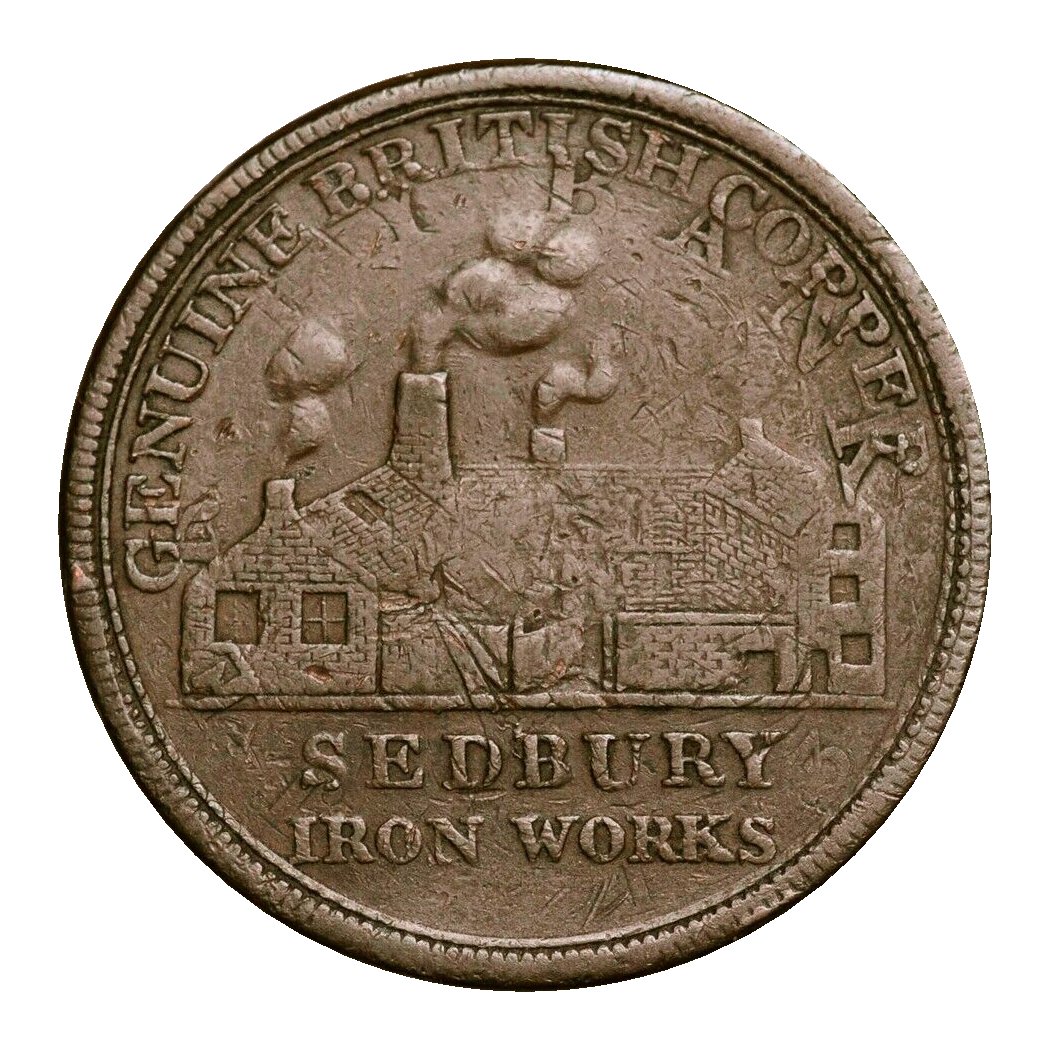 |
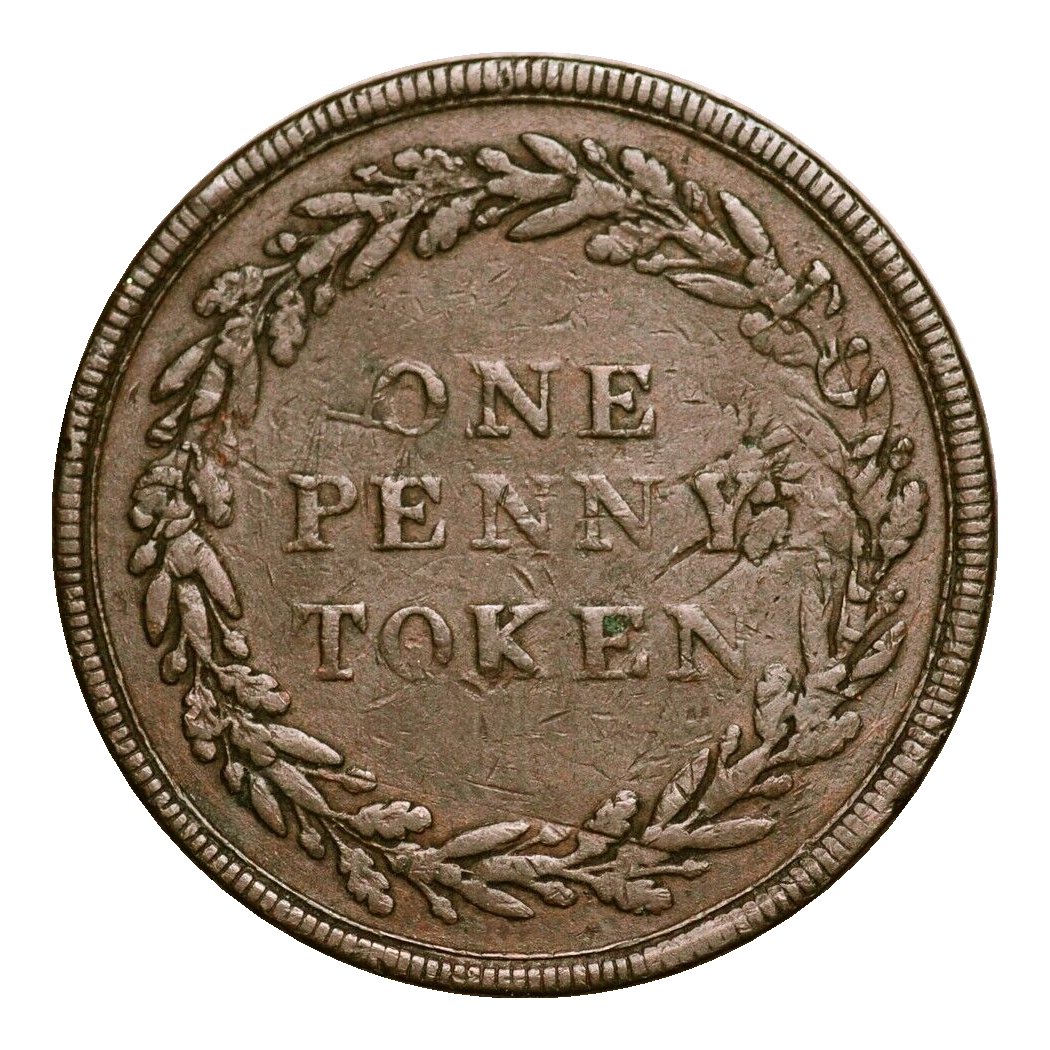 |
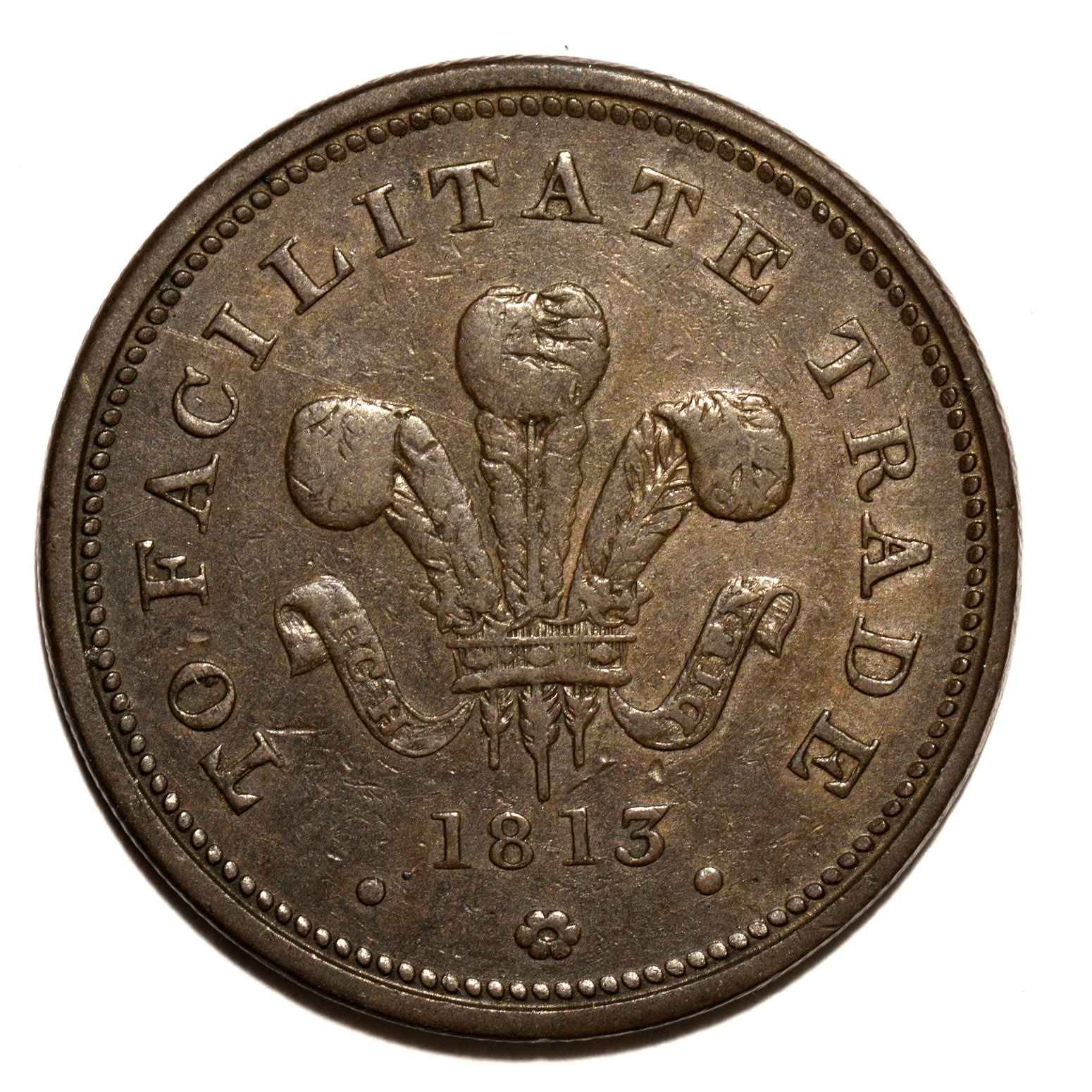 The Obverse of the 1813 Half Penny Token
The Obverse of the 1813 Half Penny Token
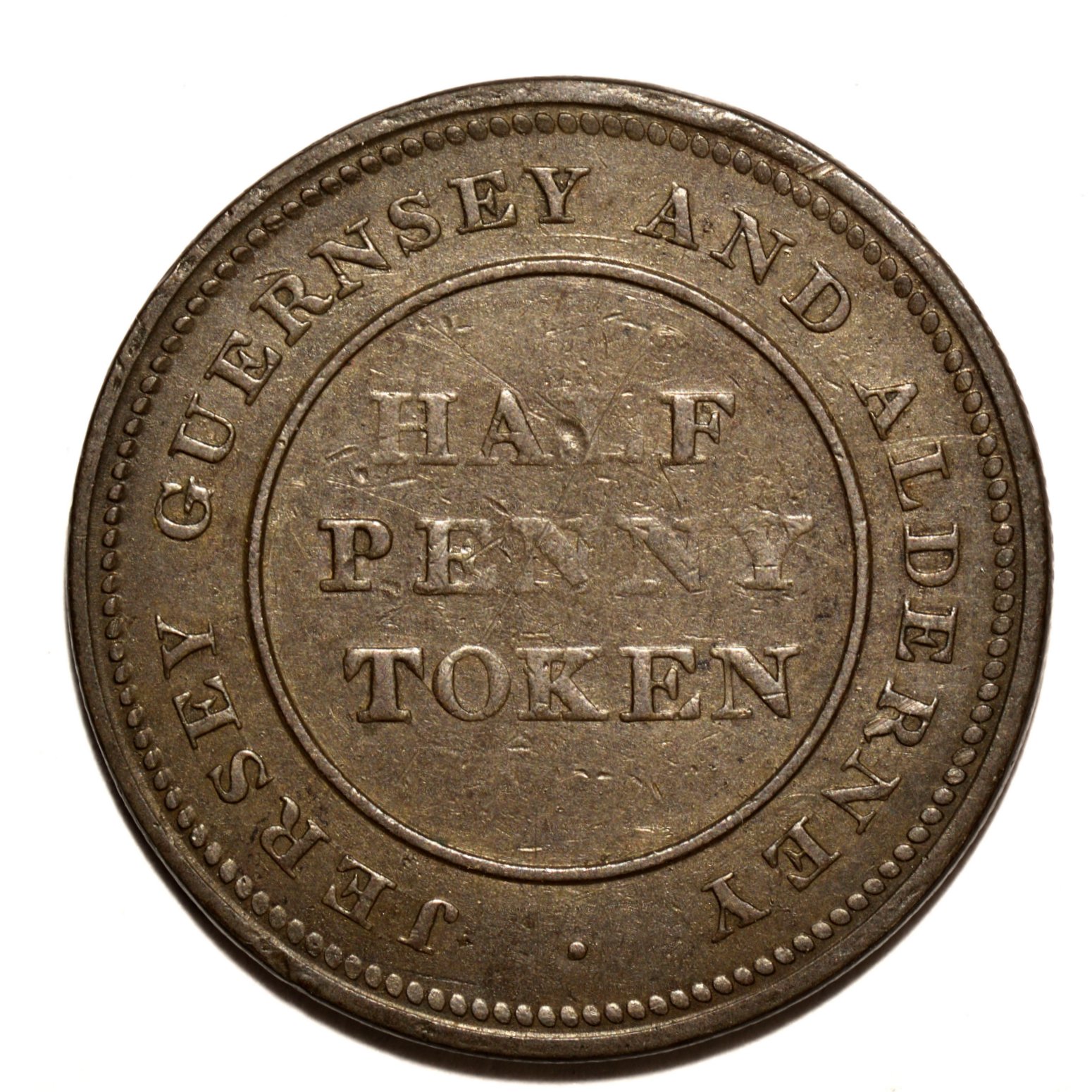 The Reverse of the 1813 Half Penny Token
The Reverse of the 1813 Half Penny Token
